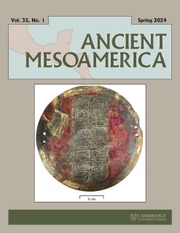Maya Blue is one of the world's most unusual pigments. Different from natural pigments derived from insects or plants, and from inorganic pigments made up of minerals such as lapis lazuli or azurite, Maya Blue consists of a human-created hybrid of the inorganic clay mineral palygorskite and the organic dye, indigo. Maya Blue is not just one color, but its color ranges from blue to turquoise to blue green, and even a green pigment can be made from palygorskite with abundant limonite and hematite (Luis May Ku, personal communication; Arnold Reference Arnold2024).
Maya Blue was first used by the prehispanic Maya beginning about 50 b.c. at the ancient site of Calakmul in south central Campeche, Mexico (Vázquez de Ágredos Pascual et al. Reference Vázquez de Ágredos Pascual, Doménech Carbó and Carbó2011). Found on pottery, murals, and sculpture, predominantly during the Late Classic, Terminal Classic, and Postclassic periods, its use extended into the early colonial period, and up into the nineteenth century.
A nanostructured clay-organic complex (José-Yacamán et al. Reference José-Yacamán, Rendón, Arenas and Serra Puche1996, Doménech et al. Reference Doménech, Doménech-Carbó and Vázquez de Agredos Pascual2009a), Maya Blue is resistant to dilute acids, alkalis, solvents, oxidants, reducing agents, moderate heat, and bio-corrosion. It has greater stability in sunlight and acids than indigo, and its color has persisted for centuries in one of the world's harshest climates—the tropical lowlands of Mesoamerica (Fois et al. Reference Fois, Gamba and Tilocca2003; Gettens Reference Gettens, Ruppert, Thompson and Proskouriakoff1955, Reference Gettens1962; Gutiérrez and Brito Guadarrama Reference Gutiérrez, Brito Guadarrama and Turner2022; José-Yacamán et al. Reference José-Yacamán, Rendón, Arenas and Serra Puche1996; Sánchez del Río et al. Reference Sánchez del Río, Martinetto, Reyes-Valerio, Dooryhée and Suárez2006).
Although chemists and material scientists have done a massive amount of research about Maya Blue (see Arnold Reference Arnold2024), archaeologists have not paralleled this enthusiasm and thus many archaeological questions remain, particularly about the objects used to make it, how the Maya made it, and whether its constituent palygorskite came from local or distant sources. Previous research has shown that the palygorskite in some samples of Maya Blue from Chichén Itzá and Palenque came from two known sources of palygorskite in Yucatan, Sacalum and Yo’ Sah Kab near Ticul (Arnold et al. Reference Arnold, Bohor, Neff, Feinman, Williams, Dussubieux and Bishop2012).
This paper continues this line of investigation and shows that the palygorskite in Maya Blue on pottery from Buenavista del Cayo in central western Belize came from the ancient mine in Sacalum, Yucatan, 375 km away (Figure 1). This result again demonstrates the value of comparing trace-element analyses of palygorskite sources with Maya Blue and reiterates its potential as a novel application of trace-element analysis to identify long-distance social interaction in ancient Mesoamerica.
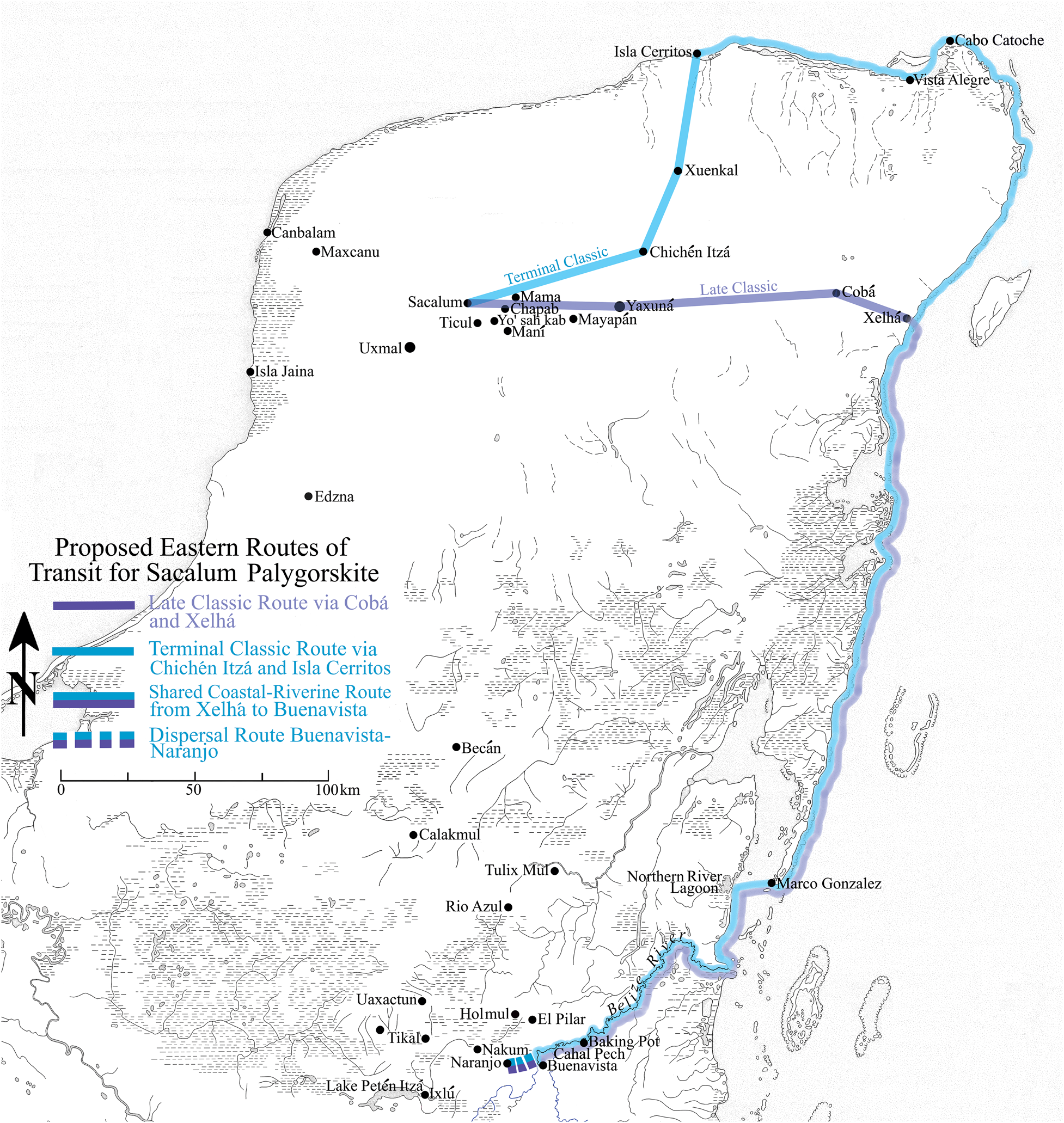
Figure 1. Map of Maya lowlands with principal sites and localities referred to in text. Chiapas and Palenque sites not shown. Two plausible maritime routes of conveyance between Sacalum, Yucatan and Buenavista del Cayo, Belize indicated: (a) hypothesized Late Classic route via Yaxuná and Cobá; (b) hypothesized Terminal Classic route via Chichén Itzá and Isla Cerritos (in color online). Map by Jennifer Taschek.
Brief history of Maya Blue research
Up until the 1960s, the composition of Maya Blue was a mystery, and details of its production unknown. Then, palygorskite (then called attapulgite) was found in the pigment using X-ray diffraction (Gettens Reference Gettens1962). That same year, Shepard (Reference Shepard1962) and Shepard and Gottlieb (Reference Shepard and Gottlieb1962) suggested that the pigment was a clay-organic complex with indigo, and, five years later, indigo was identified as the organic colorant (Kleber et al. Reference Kleber, Masschelein-Kleiner and Thissen1967); that was subsequently verified by Cabrera Garrido (Reference Cabrera Garrido1969).
From the 1960s onwards, scientists have advanced several hypotheses about how the pigment was made (Cabrera Garrido Reference Cabrera Garrido1969; Reyes-Valerio Reference Reyes-Valerio1993; Torres Reference Torres1988). The first break-through came in a 1966 paper that showed that the rich color of Maya Blue could be synthetized using palygorskite, a small amount of indigo (about 2 percent), and low heat, generally no more than 150°C (Van Olphen Reference Van Olphen1966). Although it has been repeatedly made experimentally in the laboratory using several recipes since the 1960s, Maya artist Luis May Ku has also replicated the pigment in the field in Yucatan using palygorskite and the leaves and stems of the indigo plant (Indigofera suffruticosa), scaling up its production to sell to artists (Luis May Ku, personal communication; Christie Reference Christie2022).
The discovery of indigo, Maya Blue, and palygorskite on the base of an offering in a vessel with melted copal incense from the Sacred Cenote at Chichén Itzá revealed that the ancient Maya created the pigment during the ritual of burning copal incense with palygorskite and indigo (Arnold et al. Reference Arnold, Branden, Williams, Feinman and Brown2008). Recently, Arnold (Reference Arnold2024) has discovered an additional method based upon his visual and microscopic observations of tripod bowls excavated from the Osario at Chichén Itzá by E. H. Thompson (Figure 2; Thompson Reference Thompson1938).
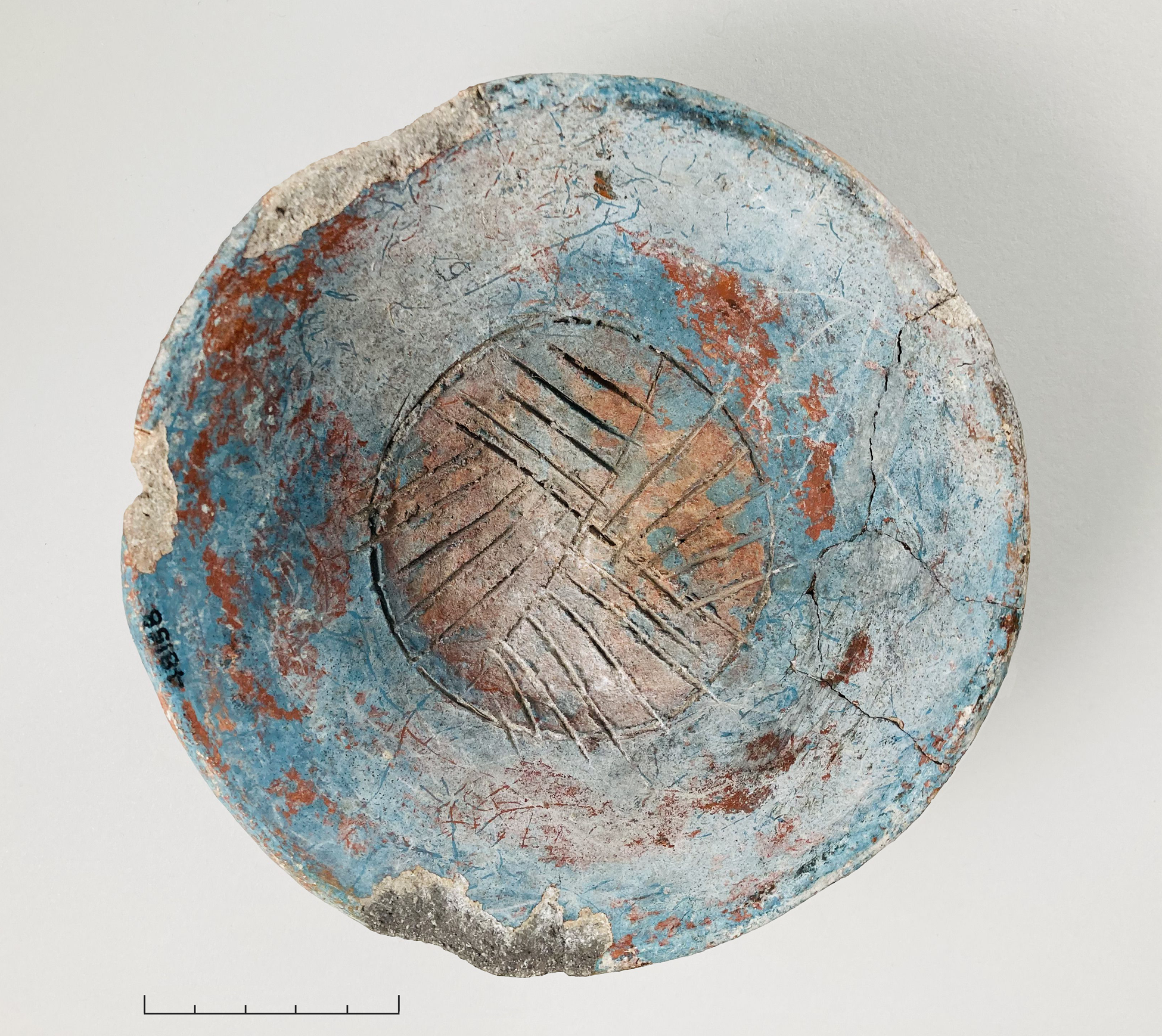
Figure 2. Maya Blue coated Papacal Incised (Mayapan Red) tripod dish from El Osario, Chichén Itzá, ca. a.d. 1050–1450. Courtesy of the Field Museum, Catalogue Number 48158. Photo by Dean E. Arnold, reprinted with permission from Maya Blue: Unlocking the Mystery of an Ancient Pigment, Reference Arnold2024, University Press of Colorado, by Dean E. Arnold.
The chemical research on Maya Blue has shown that the color variation of Maya Blue is the result of different recipes and the indigo-related chemical precursors such as indirubin and dehydroindigo that are present in the indigo plant, Indigofera suffruticosa (Doménech et al. Reference Doménech, Doménech-Carbó and Vázquez de Agredos Pascual2007, Reference Doménech, Doménech-Carbó and Vázquez de Agredos Pascual2009a, Reference Doménech, Doménech-Carbó and Vázquez de Agredos Pascual2009b and summarized in Arnold Reference Arnold2024:147–152). This research also indicated that it is unlikely that the ancient Maya used pure indigo to make Maya Blue. Consequently, the Maya probably created their unusual pigment by grinding wetted palygorskite with the leaves of the Indigofera plant or grinding the palygorskite wetted with the aqueous leachate of the plant leaves. The indigo-precursors entered the palygorskite structure with greater facility than indigo itself, and then altered to indigo with heat, creating a more stable pigment that resisted fading better than indigo (see Arnold Reference Arnold2024:147–152).
A variety of factors are responsible for the color variations of Maya Blue. The Maya prepared a yellow pigment (called “Maya Yellow”) using palygorskite and the leachate from the leaves of Indigofera suffruticosa and interrupting the process of making indigo by extracting a yellow precursor of Maya Blue (dehydroindigo) before the insoluble indigo precipitated out of the solution. A blue-green coloration can also be produced by prolonged or high heat (short of 350°C) that can also produce the yellow dehydroindigo. Further color variations may be produced by using palygorskite with abundant amounts of the hematite and limonite that occurs in some samples of the mineral from the mine in Sacalum. These minerals may also enter the pigment during its preparation in red-slipped bowls as Arnold (Reference Arnold2024:156–172) suggested from his study of the bowls from the Osario.
Cultural context of Maya Blue
Maya Blue was not just an unusual pigment, but it was a critical part of ancient Maya religion and ritual. The color blue was sacred to the Maya and was the color of sacrifice. It symbolized water, rain, and fertility and was used for sacrifices to the rain god Chaahk (Reyes-Valerio Reference Reyes-Valerio1993:86; Vail Reference Vail2006:509; Vail and Hernández Reference Vail and Hernández2018). Indeed, it symbolized the rain god Chaahk himself (Tozzer Reference Tozzer1941; Tozzer Reference Tozzer1957:195–196, 203; Vail and Hernández Reference Vail and Hernández2018) and was associated with other deities (such as Itzamná) and agriculture in one of the four surviving ancient Maya books, the Madrid Codex (Vail and Hernández Reference Vail and Hernández2018). According to a document attributed to sixteenth-century Spanish priest, Fray Diego de Landa, human sacrificial victims, and the altars upon which they were dispatched, also were painted blue (Restall et al. Reference Restall, Solari, Chuchiak and Ardren2023:99–100; Tozzer Reference Tozzer1941:117–119, Reference Tozzer1957:107, 203).
Found on copal offerings thrown into the Cenote of Sacrifice at Chichén Itzá, Maya Blue “was painted over most, if not all, of the (copal) offerings” dredged from it between 1904 and 1910 (Coggins and Ladd Reference Coggins, Ladd and Coggins1992:353). It is not likely that Maya Blue was actually painted on the offerings, however, but rather it was a result of the creation of the pigment during the performance of making the offering (Arnold et al. Reference Arnold, Branden, Williams, Feinman and Brown2008). In any case, its occurrence on such offerings was so frequent that some of the pigment washed off and sank to the bottom of the cenote, creating a layer of blue silt (Coggins Reference Coggins and Coggins1992:14; Tozzer Reference Tozzer1957:192, figure 707). Maya Blue was also widely used on pottery (Shepard and Gottlieb Reference Shepard and Gottlieb1962), on murals, and on the floors of temples at the Postclassic site of Mayapan.
Palygorskite and its modern sources
Up until the 1960s, palygorskite (then called attapulgite) was unknown in the Maya area. Based upon the triangulation of various ethnographic approaches by Arnold and analyses using X-ray diffraction by B. F. Bohor in the mid-1960s, Arnold discovered that the Maya semantic category, sak lu'um (literally “white earth”), was a part of the Indigenous ethnomineralogical knowledge of contemporary Maya potters in the town of Ticul where it was a critical ingredient of their pottery temper. In fact, sak lu'um in Ticul and in nearby Sacalum corresponds to the clay mineral palygorskite. It continues to be part of potters’ ethnomineralogical knowledge in Ticul, although by 2008, sak lu'um no longer was mined in Sacalum (Arnold Reference Arnold1967, Reference Arnold1971, Reference Arnold2008:191–220, Reference Arnold2018:77–78, 88–89, 94–107). Sak lu'um is also part of contemporary Maya ethnomedical knowledge and is used for medicinal purposes such as soothing stomach problems and diarrhea, a poultice for severe burns, and for treating mumps/goiter (papera, Arnold Reference Arnold1967).
Two contemporary sources of sak lu'um are likely ancient sources of the palygorskite used to create Maya Blue (Figure 1). These sources are part of Maya cultural heritage based upon ethnographic, ethnohistoric, and archaeological evidence. The first is a mine in the cenote in the village of Sacalum, whose name is a Hispanicized transliteration of the Yucatec Maya expression, sak lu'um. The sak lu'um is extracted from a 1 m layer of palygorskite from a cavity in the cenote interior from which miners have removed at least 307 m3 of the mineral (Arnold Reference Arnold1967, Reference Arnold2024:69–80; Arnold and Bohor Reference Arnold and Bohor1975). It also exists in a 6 cm layer that stretches across the cenote's north wall 1.5 m above the entrance to the cavity (Arnold Reference Arnold2024:80–81). Terminal Classic pottery (a. d. 800–1000) was found on the floor of the cenote, and ethnohistoric accounts suggest that the mine was used in the preconquest period (Folan Reference Folan1969).
The second probable ancient source of palygorskite (sak lu'um) consists of the area in which Ticul potters mined their temper (the “temper mines” called Yo’ Sah Kab, [‘over sah kab’]) between Ticul and the village of Chapab (Arnold Reference Arnold1967, Reference Arnold1971, Reference Arnold2008:191–220, Reference Arnold2018, Reference Arnold2024:61–69). Located in the forest on both sides of the road beginning 3.3 km from the west edge of the Plaza of Guadalupe, it was a place where potters excavated many shallow mines, tunneling into a layer of mixed palygorskite and marl that lies 1.0–2.5 m below the surface. Below this mixed layer lies a solid bed of palygorskite that is 0.5 to 1.0 m thick (Arnold Reference Arnold2008:191–220, Reference Arnold2018, Reference Arnold2024:62). A Terminal Classic archaeological site was discovered here in 1967 but subsequently was destroyed by repeated extraction of the palygorskite-containing marl for preparing pottery temper (Arnold Reference Arnold2005).
Although other deposits of palygorskite have been found in several parts of the Yucatan peninsula (Arnold Reference Arnold2024:88–100, Arnold et al. Reference Arnold, Neff, Glascock and Speakman2007; Krekeler and Kearns Reference Krekeler and Kearns2009, Sánchez del Río et al. Reference Sánchez del Río, Suárez and García-Romero2009), the ancient Maya probably did not extract palygorskite from these deposits. Rather, many of them were exposed by road building, explosives, and modern construction and were likely not accessible to the ancient Maya (Arnold Reference Arnold2005; Reference Arnold2024:88–100).
Trace elements in palygorskite
To discover the ancient sources of the palygorskite in Maya Blue, it is first necessary to analyze the trace elements in palygorskite from a wide range of sources, and then determine whether each source can be differentiated by its trace elements. Between 1965 and 1997, Arnold and Bohor collected 33 samples of palygorskite from various parts of the Maya area. Instrumental neutron activation analysis (INAA) and laser ablation inductively coupled plasma mass spectrometry (LA-ICP-MS) analyses of these samples revealed that palygorskite from different sources could indeed be differentiated compositionally (Arnold et al. Reference Arnold, Neff, Glascock and Speakman2007). Consequently, it was possible to test the hypotheses that the palygorskite used to make Maya Blue came from widespread sources, and that it came from a single source or a small number of sources.
Subsequent field work in 2008 expanded the number of palygorskite samples available and analyses of them revealed that the same elements distinguished the same sources as they did in the earlier pilot study (Arnold et al. Reference Arnold, Neff, Glascock and Speakman2007). These analyses thus confirmed that Sacalum and Yo’ Sah Kab could be differentiated from one another and from other sources (Arnold et al. Reference Arnold, Bohor, Neff, Feinman, Williams, Dussubieux and Bishop2012). Most of the new samples from Sacalum fell within the high-yttrium main Sacalum group and this element reliably discriminated the palygorskite from Sacalum from that from other sources. A smaller group of samples came from the thin band on the cenote wall and displayed yttrium values consistent with Yo’ Sah Kab, but with higher vanadium and chromium. X-ray fluorescence (XRF) data confirmed the distinctiveness of this group from both the main Sacalum group and the Chapab and Yo’ Sah Kab groups (Arnold et al. Reference Arnold, Bohor, Neff, Feinman, Williams, Dussubieux and Bishop2012).
Relating the trace elements in palygorskite to Maya Blue
The next step of investigation determined whether the composition of the known sources of the mineral matched the palygorskite in the Maya Blue. This step involved comparing the trace elements in the pigment with those in the samples of palygorskite that Arnold and clay mineralogist, Bruce F. Bohor, had collected in Yucatan over the previous 43 years (Arnold et al. Reference Arnold, Bohor, Neff, Feinman, Williams, Dussubieux and Bishop2012).
The Maya Blue analyzed came from the Field Museum collection (N = 6) and from the archaeometry lab (IIRMES) at California State University at Long Beach (N = 3). The Field Museum samples originally came from Edward H. Thompson's 1896 excavation of the Osario (the Grave of the High Priest) at Chichén Itzá (Figure 2; Thompson Reference Thompson1938), and from a bowl recovered from Thompson's dredging of the Sacred Cenote there (Arnold et al. Reference Arnold, Bohor, Neff, Feinman, Williams, Dussubieux and Bishop2012).
The analyses of the Maya Blue samples fell within the same range of variation as most of the analyses of the palygorskite from Sacalum and Yo’ Sah Kab. All of the samples from Chichén Itzá were made with palygorskite from Sacalum. Samples of the pigment from Palenque were also attributed to Sacalum, to Yo’ Sah Kab near Ticul, and to a possible unknown source (Arnold et al. Reference Arnold, Bohor, Neff, Feinman, Williams, Dussubieux and Bishop2012). This result successfully tested the hypothesis that Sacalum and Yo’ Sah Kab were ancient sources of palygorskite used in the production of these samples of Maya Blue. These results thus appear, initially at least, to put to rest the hypothesis that Maya Blue was produced from local sources of palygorskite, rather than from the two contemporary sources of sak lu'um recognized by the modern Maya as part of their cultural heritage.
These analyses lay the groundwork for assessing the spread of palygorskite and/or Maya Blue throughout Mesoamerica by means of the movement of the pigment, and/or palygorskite, along with the transfer of the technology used for making the pigment (Arnold Reference Arnold2024:176–195). Were Sacalum and Yo’ Sah Kab the sources of palygorskite for Maya Blue found at other sites in the Maya area? Some evidence exists that there were at least one, or maybe two, other sources of palygorskite used for Maya Blue (Arnold et al. Reference Arnold, Bohor, Neff, Feinman, Williams, Dussubieux and Bishop2012; Cecil Reference Cecil2010; Vázquez de Ágredos Pascual et al. Reference de Ágredos Pascual, Luisa, Roldán-García, Mucia-Mascarós, Barber, Jaén Sánchez, Faugère and Darras2019). Nevertheless, comparing trace-element analyses of Maya Blue with those of palygorskite from Sacalum and Ticul can provide another important indicator of cultural and social interaction in ancient Mesoamerica.
The present sample set
Buenavista del Cayo
The samples of Maya Blue analyzed in this study came from Buenavista del Cayo (hereafter Buenavista) in the upper Belize River Valley of central western Belize (Figure 1). The pigment occurs on a restricted typological corpus of vessels from the site. However, it is present in regnal or high elite palace contexts of both full Late Classic (ca. a.d. 680~780/790) and early Terminal Classic periods (ca. a.d. 780/790~860+). A number of Late Classic ceremonial vessels also were embellished with the pigment (Table 1; Supplemental Table 1).
Table 1. Blue-embellished pottery sherds from Buenavista del Cayo, Belize submitted for LA-ICP-MS palygorskite analysis by the Elemental Analysis Facility, Field Museum, Chicago
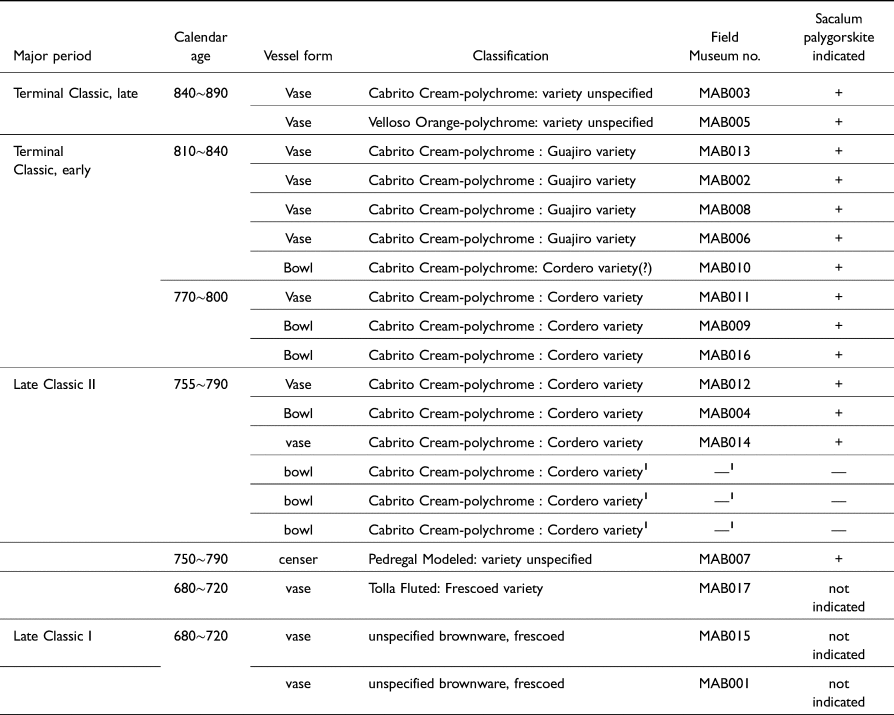
Note: LA-ICP-MS = laser ablation inductively coupled plasma mass spectrometry.
1. Sample too small for analysis.
Buenavista is a modest, medium-sized center situated on the east bank of the Rio Mopan just above its confluence with the Macal to form the Belize River. It embodies a “classic” organizational center morphology including a central ceremonial plaza, elite palace complex (West Palace Group), multiple “intermediate elite” residential groups, and a periodic marketplace (Ball and Taschek Reference Ball and Taschek1991, Reference Ball, Taschek, Takeshi and Houston2001, Reference Ball, Taschek and James2004, Reference Ball and Taschek2018; Blankenship-Sefczek et al. Reference Blankenship-Sefczek, Ball and Taschek2021; Brown and Yaeger Reference Brown, Yaeger, Houk, Arroyo and Powis2020; Cap Reference Cap2015; Hyde Reference Hyde2013; Peuramaki-Brown Reference Peuramaki-Brown2012, Reference Peuramaki-Brown2014; Yaeger et al. Reference Yaeger, Kurnick, Dykstra and Peuramaki-Brown2012, Reference Yaeger, Batty, Bratsch, Cap and Whitaker2013). The site was surveyed, mapped, and partially excavated between 1984 and 1989 as part of an initial, exploratory reconnaissance of the upper Belize Valley by the San Diego State University (SDSU) Mopan-Macal Triangle Archaeological Project (MMTAP). Excavations in 1988 and 1989 focused on sampling the site's Central Plaza, South Plaza Group, and the south court of its palace complex or West Palace Group (Figure 3).
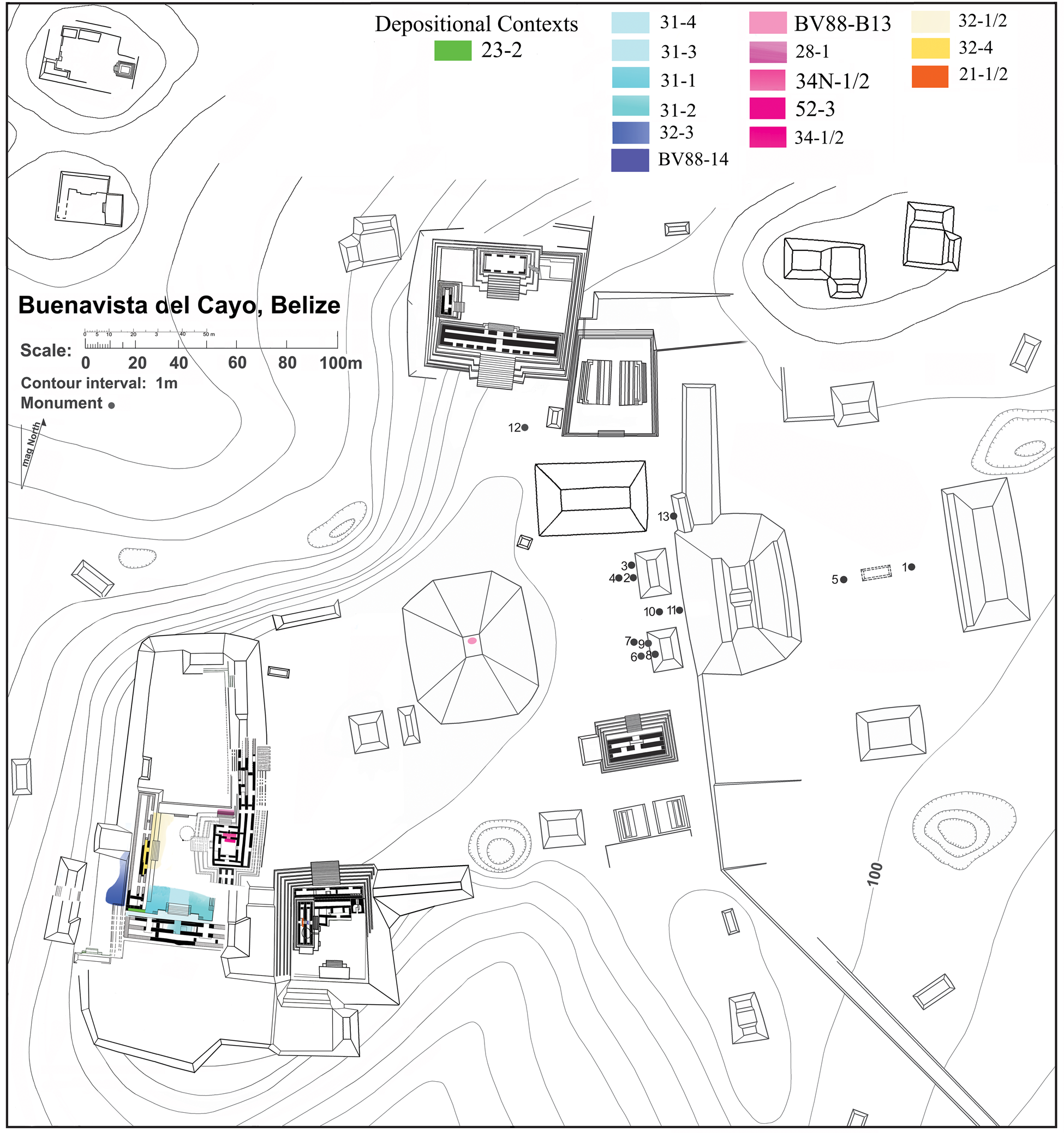
Figure 3. Plan-map of Buenavista del Cayo, Belize indicating principal structures and depositional contexts referred to in text (in color online). Map by Jennifer Taschek.
The known occupational history of the site began in the Middle Preclassic and continued with occasional breaks into the early decades of the local early Postclassic (ca. a.d. 950~1150). Monumental construction at the site was underway by at least the early Late Preclassic (ca. 400~50 b.c.) and continued intermittently into the late eighth century. By the early first century a.d., Buenavista was a significant local center and an important focus of ceremonial and organizational activity for the upper Belize Valley.
Maya Blue sample contexts at Buenavista
Excavations within the Buenavista palace complex encountered a large number of discrete, well-preserved on-floor cultural deposits (Figure 3). One of these (depositional context 32-3) was a deep refuse accumulation resulting from two or more formal feasts hosted within the complex between roughly a.d. 770 and 790. Multiple vessels of the Cabrito Cream-polychrome and K'om polychrome types adorned with labial and basal decorative bands of Maya Blue were recovered from this deposit. Another (depositional context 31-1/2), dating to ca. a.d. 810~860+, was a rich accumulation of mixed artisanal crafting and elite residential debris. The craft activities represented included fine bone ornament manufacture and polychrome pottery painting, firing, and post-firing blue overpainting (Ball et al. Reference Ball, Taschek, Almada and Sears2025). Maya Blue pigment was widely used on the pottery produced there, which comprised an extensive range of vessel forms of the Guajiro variety of the Cabrito Cream-polychrome type (Table 1). Complete to nearly complete vessels of Cabrito Cream-polychrome embellished with Maya Blue paint were recovered from other peri-abandonment deposits within the rooms and courtyards of the palace (depositional contexts BVDC 28-1; 32-2; 34-1; Table 1; Supplemental Table 1).
We supplemented the palace samples with sherds from three frescoed vases dating to ca. a.d. 680~720 recovered from high-status residence debris at Structure 21 (MAB001; MAB015) and a regnal burial atop Structure 1 (BV88-B13; MAB017). Finally, we added a fragment (MAB007) of a locally made unslipped but elaborately appliquéd, modeled, and blue-painted full Late Classic (ca. a.d. 745~780) effigy censer-stand depicting the Jaguar God of the Underworld recovered from the collapse atop one of Buenavista's two principal funerary monuments, Structure 1.
Analytical procedures
The analyses were conducted at the Field Museum of Natural History with a Thermo ICAP Q inductively coupled plasma mass spectrometer (ICP-MS) connected to an ESI-Elemental Scientific Lasers NW213 laser for the direct introduction of solid samples. The parameters of the ICP-MS are optimized to ensure a stable signal with a maximum intensity over the full range of masses of the elements and to minimize oxides and double ionized species formation (XO+/X+ and X++/X+ < 1 to 2 percent). For that purpose, the argon flows, the radio frequency (RF) power, the torch position, the lenses, the mirror, and the detector voltages are adjusted using an auto-optimization procedure.
For better sensitivity, helium is used as a gas carrier in the laser. Scan lines were used to sample the Maya Blue pigment at the surface of the ceramic sherds. When using scan lines, a “cleaning” ablation (called pre-ablation) is set up to remove any dirt at the surface of the objects. When using the usual setting parameters for this pre-ablation (laser operating at 20 percent of its energy with a pulse frequency of 10 Hz and a speed of 70 μm/s), however, the blue pigment would totally disappear. When a second ablation would take place subsequently at the same location, no pigment would be left and only what was underneath would be sampled and measured. To avoid this problem, the pre-ablation step was eliminated because a possible surface contamination would be better than leaving no Maya Blue at all on the sample.
The parameters for the laser ablation were 20 percent of energy, a pulse frequency of 10 Hz and a speed of 70 μm/s. Each sherd was ablated and measured five times and the average of these five measurements was used to calculate the composition of the Maya Blue pigment present on each sherd.
To improve reproducibility of measurements, the use of an internal standard is required to correct possible instrumental drifts or changes in the ablation efficiency. The element chosen as an internal standard has to be present in relatively high concentration, so its measurement is as accurate as possible. In order to obtain absolute concentrations for the analyzed elements, the concentration of the internal standard has to be known and the isotope Si29 was used for this purpose. Concentrations for major elements, including silica, are calculated assuming that the sum of their concentrations in weight percentage in this standard is equal to 100 percent (Gratuze Reference Gratuze, Dussubieux, Golitko and Gratuze2016).
Quantitative results are obtained by comparing the signal intensity measured for a given element in a sample to the signal intensity for the same element in an external solid standard reference material (SRM) with certified concentrations. To prevent matrix effects, the composition of the standards must be as close as possible to that of the samples. Two standard reference materials are used. One was SRM 679 and was created by the National Institute for Standards and Technology (NIST). It consisted of a clay in a powdered form that was formed into a solid briquette by mixing it with ultra-pure water, shaping it into a small pellet, and then firing it for one hour at 1,000°C. Unfortunately, certified values for SRM 679 are available for only a limited number of major and minor elements. This limitation for trace elements was overcome by using SRM 610, a soda-lime-silica glass doped with trace elements with concentrations of about 500 ppm with certified values and concentrations from Pearce et al. (Reference Pearce, Perkins, Westgate, Gorton, Jackson, Neal and Chenery1997). In order to check the reliability and consistency of our results, Ohio Red clay, in the form of a briquette, was prepared in the same way as SRM 679, and was treated as a sample in the analysis. To check the consistency of the standards, the external standards and Ohio Red clay were analyzed several times in a day, and after every five samples or fewer (Dussubieux Reference Dussubieux2023).
Analytic results
Seventeen samples were analyzed. They were renumbered MAB001 to 017 (Table 1; Supplemental Tables 1 and 2).
A few samples contain very large concentrations of calcium, with MAB015 and MAB017 having the highest at respectively ~87 percent and 92 percent of CaO (see Figure 4 and Supplemental Table 2). The blue pigment was particularly faint at the surface of the sherds and a white layer underneath was clearly visible, so our measurements of these samples has quite likely captured the composition of the calcium-rich layer underneath the palygorskite rather than the composition of the palygorskite itself. Sample MAB001 contains a much lower concentration of calcium (CaO = 17 percent) but the blue seems to have been applied over a layer of calcium-rich material as was the case for MAB015 and MAB017. The concentrations of vanadium and lanthanum for MAB001 are quite comparable with that of the bulk of the samples from Buenavista but its yttrium concentration is higher, maybe due to the application of the blue pigment on top of a calcium-rich layer.
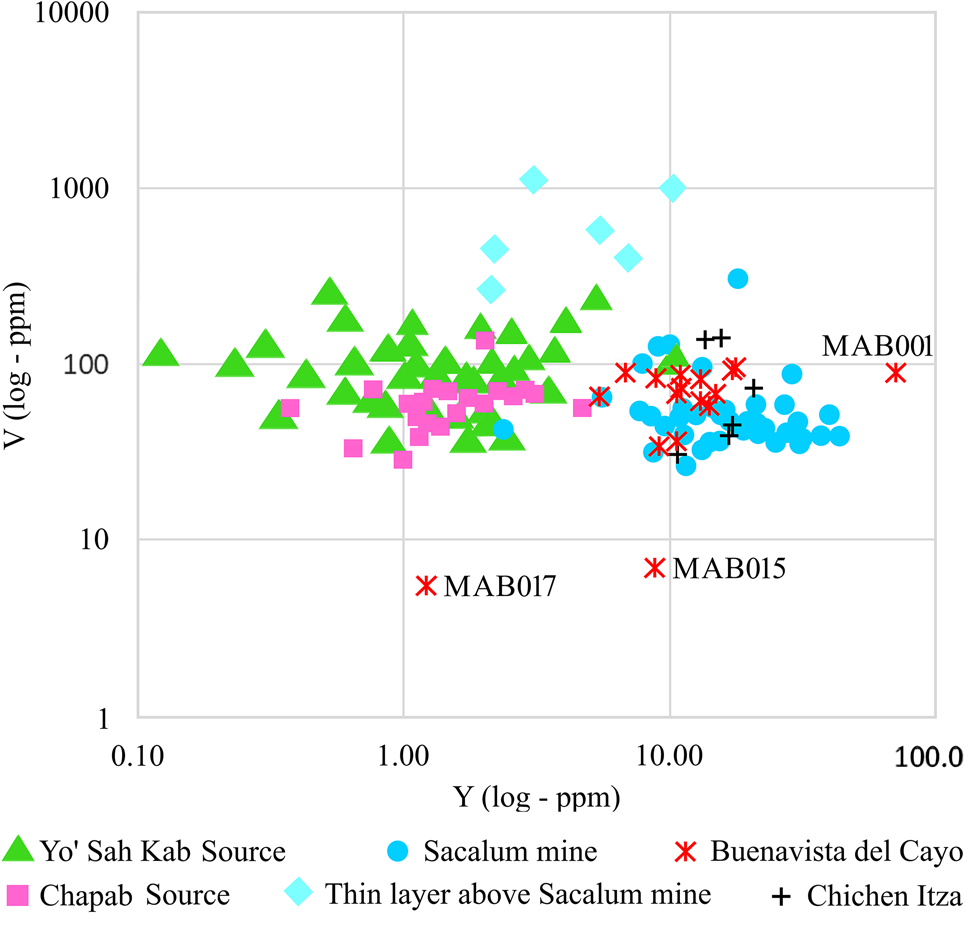
Figure 4. Divergent high-calcium frescoed samples from Buenavista, MAB001, MAB015, and MAB017. Base scatterplot shows yttrium and vanadium concentrations for sources of palygorskite previously described in Arnold et al. (Reference Arnold, Bohor, Neff, Feinman, Williams, Dussubieux and Bishop2012), the samples from the Osario and the Cenote Sagrado at Chichén Itzá (FM 2006), and other samples analyzed for the present study (in color online).
It is likely that the high calcium composition in some of the samples says something about the preparation of the vessel surface for affixing Maya Blue, or about the technique used to apply it and why that was used. It may also involve the final effect the painter wanted to achieve. The blue is different when applied on a white background (more light blue) than on a brown background (darker blue). The calcium layer under the pigment might be a binder to help it adhere to the vessel. Maya Blue is a fugitive pigment because of the crystal structure of the palygorskite and requires some kind of a binder for the pigment to cohere and adhere to surfaces (Arnold Reference Arnold2024:31–34). Furthermore, Maya Blue was first used on sculpture and stucco before it was applied to pottery and murals, and the Maya may have discovered that in order to use the pigment on pottery they had to either add some quicklime (CaO) to the pigment and/or place quicklime on the areas of the vessel that would receive Maya Blue so that it would cohere together and adhere to the vessel.
In a pilot study comparing trace-element composition from various palygorskite deposits, Arnold et al. (Reference Arnold, Neff, Glascock and Speakman2007) found that lanthanum, rubidium, manganese, and nickel separated the modern sources of palygorskite at Sacalum, Yo’ Sah Kab, and Chapab from the palygorskite deposits near Uxmal, in a cenote near Mama, near Maxcanu, in the southern Petén (that analyzed by Cecil Reference Cecil2010). After sampling a much larger universe of palygorskite deposits in 2008, yttrium was found to separate the Yo’ Sak Kab and the Chapab sources from the large palygorskite mine in the cenote of Sacalum that usually contained more yttrium than the two other sources. Lanthanum also occurred in higher concentrations in the palygorskite in the Sacalum mine than it did in the Yo’ Sak Kab and the Chapab sources (Arnold et al. Reference Arnold, Bohor, Neff, Feinman, Williams, Dussubieux and Bishop2012). Chromium and vanadium characterized palygorskite from the thin (6 cm) layer above the large mine (called Sacalum-1), distinguishing it from that found in the larger quarry below it.
The data presented here parallel some of the results from earlier analyses of Maya Blue from Chichén Itzá and Palenque (Arnold et al. Reference Arnold, Bohor, Neff, Feinman, Williams, Dussubieux and Bishop2012). Figures 5 and 6, using yttrium, vanadium, and lanthanum, show that the samples from Buenavista are different from the Chapab and the Yo’ Sah Kab source and also from the thin layer above the large mine in the cenote in Sacalum (Sacalum-1), but they do overlap with the palygorskite samples from the large mine itself. When using yttrium and lanthanum (Figure 6), the samples from the large mine in Sacalum and in the thin layer above it (Sacalum -1) also overlap. Only the concentrations of vanadium as seen in Figure 5 can distinguish them. Samples MAB015 and MAB017, containing high quantities of calcium, follow a different trace-element pattern with notably much lower concentrations of vanadium (Figure 4).
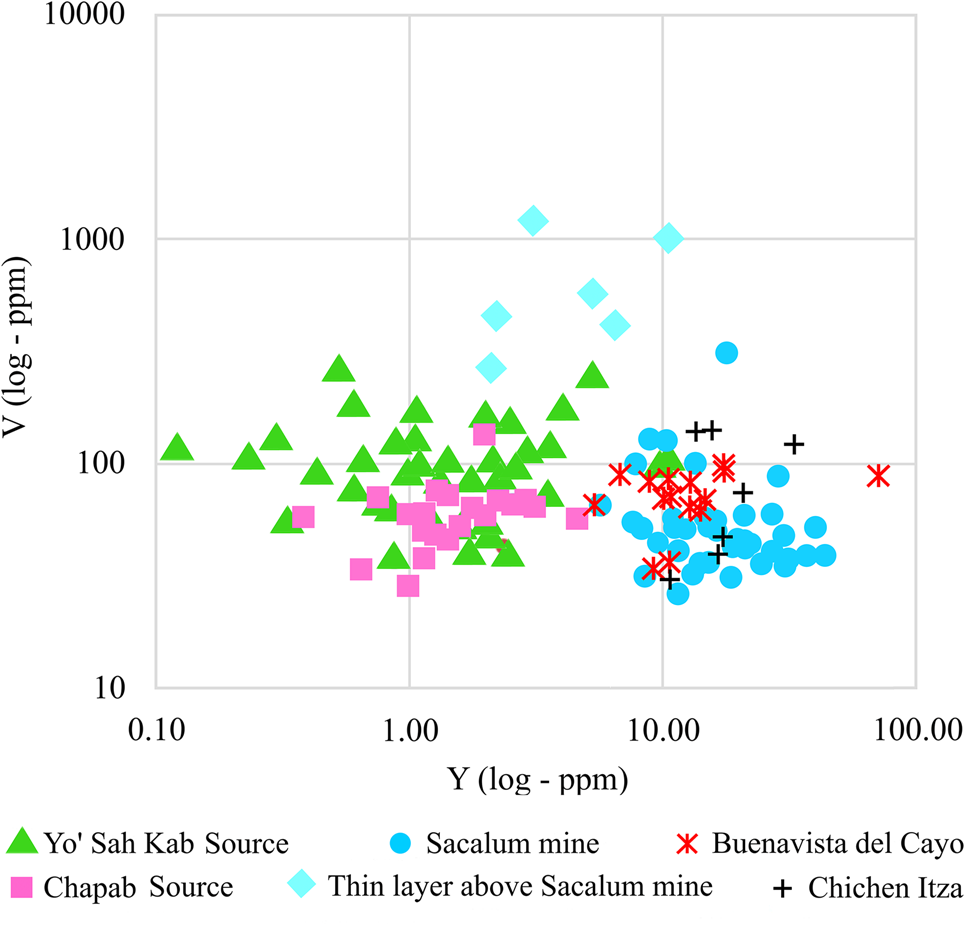
Figure 5. Scatterplot of yttrium and vanadium concentrations for sources of palygorskite described in Arnold et al. (Reference Arnold, Bohor, Neff, Feinman, Williams, Dussubieux and Bishop2012), the samples from the Osario and the Cenote Sagrado at Chichén Itzá (FM 2006), and the samples analyzed for the present study (in color online).
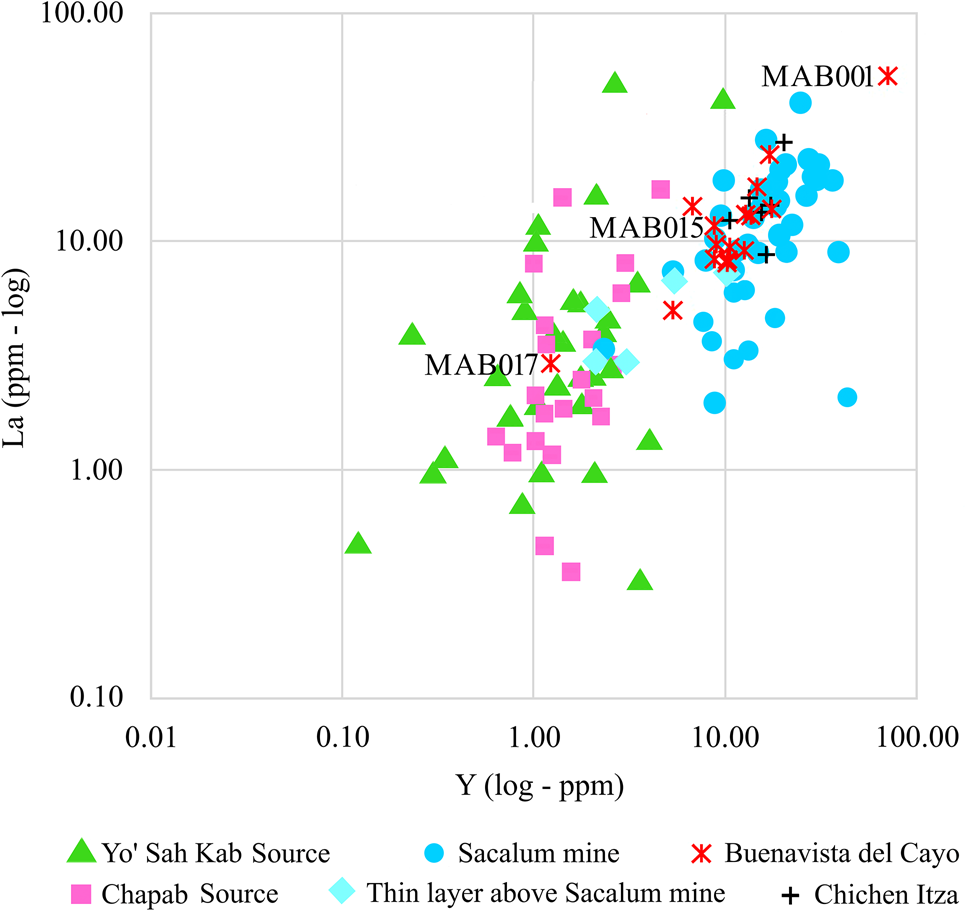
Figure 6. Scatterplot of yttrium and lanthanum concentrations for sources of palygorskite described in Arnold et al. (Reference Arnold, Bohor, Neff, Feinman, Williams, Dussubieux and Bishop2012), the samples from the Osario and the Cenote Sagrado at Chichén Itzá (FM 2006), and the samples analyzed for the present study (in color online).
Cecil's (Reference Cecil2010) analysis of trace elements in Maya Blue from Postclassic Ixlú in central Petén (Figure 1) suggests the presence of an additional source of palygorskite in the region. This conclusion is based on the mismatch between the trace elements found in the Ixlú samples provided by Cecil (Reference Cecil2010) and those from Yucatan, as reported by Arnold et al. (Reference Arnold, Neff, Glascock and Speakman2007). By comparing the composition of Maya Blue with local pottery from the area around Lake Petén Itzá, Cecil found similarities that suggest a local source for the palygorskite used in the Maya Blue from Ixlú. As the latter is situated approximately 60 km west southwest of Buenavista (Figure 1), it is surprising that the palygorskite in the Maya Blue samples from Buenavista did not originate from this Petén source, wherever it may be.
The Ixlú Maya Blue and its palygorskite source may be linked in time and space to other Postclassic occurrences of the pigment. An early Postclassic cache consisting of four apple-sized balls of copal with Maya Blue (Shepard and Gottlieb Reference Shepard and Gottlieb1962) was discovered in an unsealed pit dug into the floor between Rooms 1 and 2 of the building atop Temple 1 at Tikal (Adams and Trik Reference Adams and Trik1961:119, 131, figures 40b–c). The Tikal offering, found just 25 km north of Ixlú, is believed to belong to the Petén Postclassic tradition (Cecil Reference Cecil2010) of Maya Blue production and use. Notably, the Postclassic Kowoj and Itza Maya of the Petén Lakes region both overtly emulated many cultural and ideological practices of the Mayapan Maya, including their incensario traditions (Pugh Reference Pugh, Rice and Rice2009:382; Rice and Rice Reference Rice and Rice2009, Reference Rice and Rice2018) and ceramic adornment with Maya Blue. The specialized knowledge required to manufacture Maya Blue using palygorskite, leaves from the indigo plant (Indigofera suffruticosa), and heated copal, was likely privileged and closely guarded, making that knowledge itself a highly valued commodity (Inomata Reference Inomata2001, esp. 332) from the north.
The sources of palygorskite to make Maya Blue in the southern lowlands thus appear to have changed in the Postclassic period. This pattern also occurred in Central Mexico because the palygorskite in at least a few Aztec samples of Maya Blue did not come from Yucatan as they had in earlier examples from the Epiclassic period, but instead came from an unknown source (Sánchez del Río et al. Reference del Río, Manuel, Suárez and García-Romero2021).
Maya Blue at Buenavista and Beyond in the greater eastern lowlands: usage history, sources, and plausible conveyance
Maya Blue at Buenavista: occurrence history and chronology
The earliest encountered use of blue paint at Buenavista was found on fragments from the elaborately modeled and richly polychromed stucco façade of an elite Middle Classic residential building, Structure 21 (Figure 3), deliberately burned and demolished sometime between a.d. 690 and 700. Possibly the home of Buenavista's Early through Middle Classic regnant family, the building was originally constructed between a.d. 420 and 560, and the façade most probably dated to this period as well (Ball and Taschek Reference Ball and Taschek2018). Regrettably, no examples of the latter were retained for analysis, and all recovered architectural debris were reburied on site.
The first known use of Maya Blue at Buenavista to embellish ceramics occurs contemporaneously in several contexts, all directly or indirectly associated with the final occupation of this same building and dating to sometime between a.d. 660 and 700.
The pottery vessels and other artifactual materials in use by the occupants of Structure 21 were deliberately smashed and burned at the time of its fiery destruction in the final decade of the seventh century. So, extracting readily usable information from them is not straightforward. Field circumstances at the time of excavation also made complete recovery of the deposit infeasible, so some unknown quantities of relevant materials were not retrieved. There appear to have been several pale-orange and light-brown (Munsell 7.5YR5.5/7–8) monochrome vessels and at least four bright red fluted vases (Tolla Fluted) all of which had been thinly coated with plaster and then painted fresco-style with pale grayish-blue, light blue, and other pastel colors (Samples MAB001, MAB015, MAB017; Table 1; Supplemental Table 1).
The best-preserved vessels of this kind were recovered from the roughly contemporary tomb of an elite adolescent female, Burial BV88-B13, Structure 1, on Buenavista's Central Plaza (Figure 3; Ball and Taschek Reference Ball and Taschek2018). Neutron activation analysis of two of the blue frescoed fluted vases indicated that they had been made at the giant Petén city-center, Naranjo-Sa'aal, located just 14 km west of Buenavista (Figure 1; Ball et al. Reference Ball, Taschek, Almada and Sears2025). The fresco-style technique employed in embellishing these vases is the same that was used to apply blue coloring to Buenavista's well-known “Jauncy Vase” (Figure 7), others of the very finest presentation, and funerary ceramics of the High Late Classic period, ca. a.d. 680~780. LA-ICP-MS analysis of a sample from one of these vases, MAB017 (Figure 8; Table 1), indicated a singularly high calcium content but failed to clearly identify a recognizable palygorskite signature. This currently is a mystery requiring further research and analysis, but it could mean that Maya Blue had been added directly to a thin layer of wet plaster—a true fresco technique, mimicking in practice earlier architectonic embellishments, but overwhelming the signal from the Maya Blue because of its very low concentration.
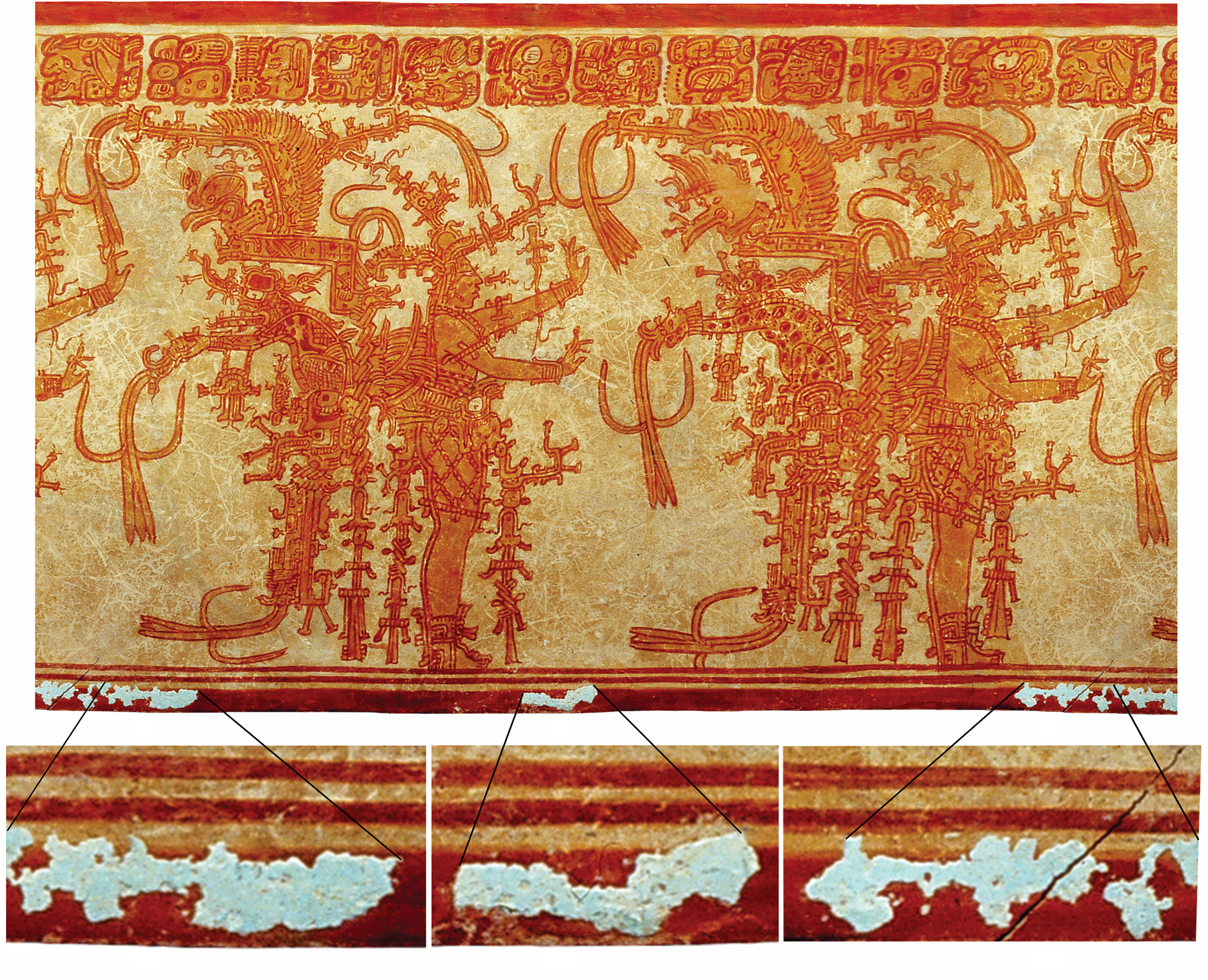
Figure 7. The Jauncy Vase (Cabrito Cream-polychrome: Cabrito variety), ca. a.d. 690~720; manufactured at Naranjo-Sa'aal (Guatemala), excavated at Buenavista del Cayo (Belize), Burial BV88-B11. Note fresco mode of blue application in 4× enlargements of basal band. Rollout © Justin Kerr (K4464), Justin Kerr Archive, Dumbarton Oaks, Trustees for Harvard University, Washington, DC.
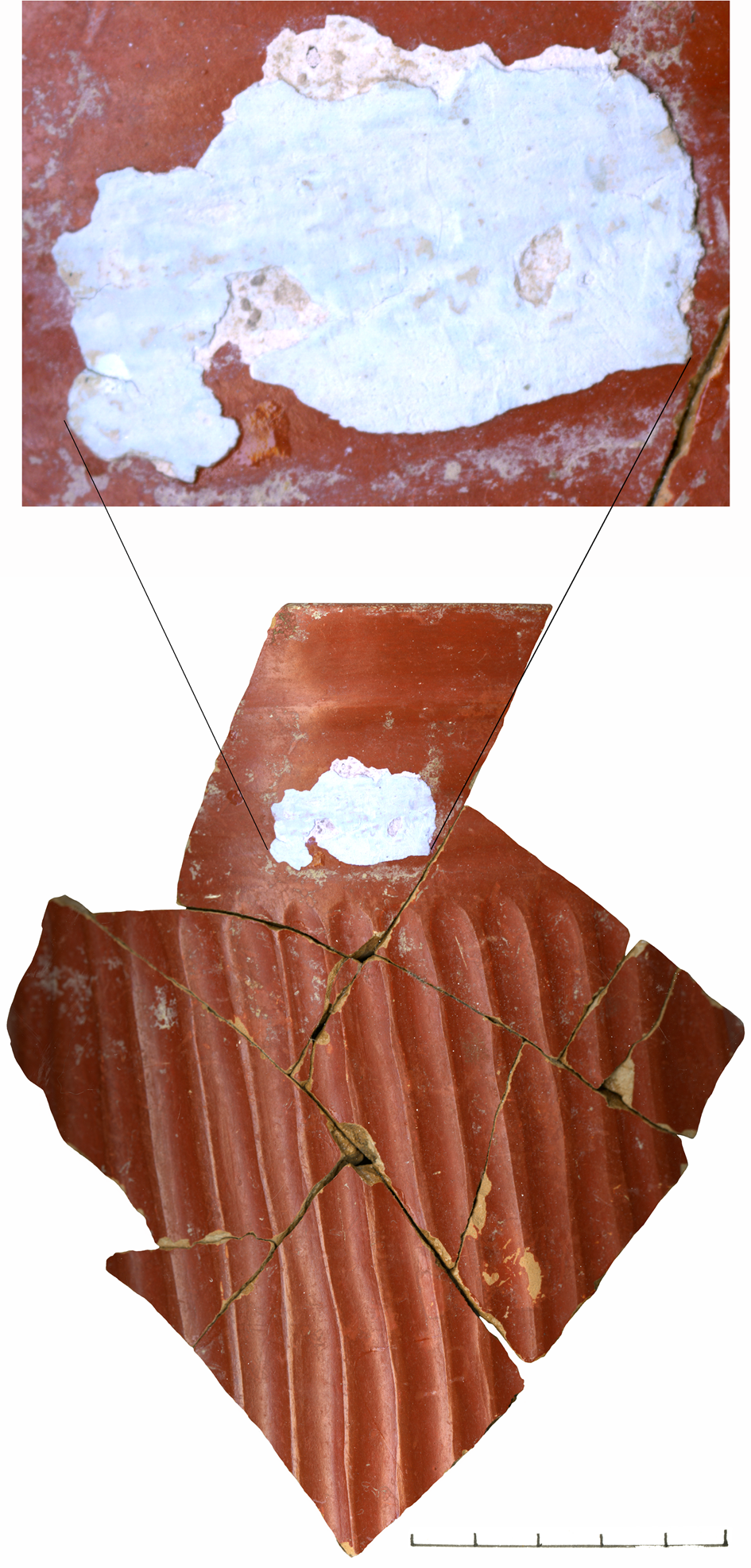
Figure 8. Blue pigment examples, early eighth century. Frescoed fluted redware (Tolla fluted) vase, Burial BV88-B13, Structure 1, Buenavista. Image by Jennifer Taschek.
Between a.d. 680 and 790, light-blue painting occurred at Buenavista on very fine nonlocal ceramics from the major eastern Petén centers of Naranjo (14 km distant), Holmul (24 km distant), and at least one other yet-to-be-identified location most probably in the upper Belize Valley (Ball et al. Reference Ball, Taschek, Almada and Sears2025). Initially, between 680 and 760, only vessels of the Cabrito variety of Cabrito polychrome were represented, and these invariably were decorated solely with pale-blue frescoed labial and basal bands. The Buenavista “Jauncy Vase” (Figure 7) is one of the best-known Classic-period funerary ceramics professionally recovered in the Maya lowlands. The vessel was created and painted in Naranjo-Sa'aal workshops between a.d. 690 and 720 under the aegis of Naranjo K'uhul Ajaw, K'ak' Tiliw Chan Chaahk, and gifted to the Buenavista royal house at some point during that period. As can be seen in the accompanying image, blue pigment was applied as a very pale embellishment to the plastered-over red-painted basal and labial bands. The blue application is effectively frescoed, although whether applied al fresco or fresco-secco has not been determined. Samples MAB017, MAB015, and MAB001 (Table 1) are contemporary examples of this same technology. LA-ICP-MS analysis of these three samples did not identify a clear presence of Sacalum or Ticul palygorskite but did indicate an especially high calcium component for the thin plaster layer.
Other frescoed vessels are known as rarities from only a very few contemporary contexts in the Belize Valley as of this writing. One of these is from an early Late Classic (ca. a.d. 680~710) tomb at nearby Cahal Pech. This vessel is a brown-on-light-brown bichrome vase very similar in typology and appearance to that from which Buenavista samples MAB001 and MAB015 came. It is richly frescoed in pastel polychromy (Figure 9; Novotny et al. Reference Novotny, Awe, Santasilia and Knudson2018:647, figure 5a; Santasilia Reference Santasilia2013:45, figure 31a), including a clear pale blue green or aqua. The badly eroded imagery depicts a monstrous serpent—possibly the Earth Monster, possibly Quetzalcoatl. Brown glosswares are typical of the Veracruz Gulf Coast and Teotihuacan in the Early through Middle Classic (Rattray Reference Rattray2001) and of the Preclassic through Classic periods in the Guatemalan Highlands (Rands and Smith Reference Rands, Smith, Willey and Wauchope1965). While present, they are far less common in the Late Classic Maya lowlands.
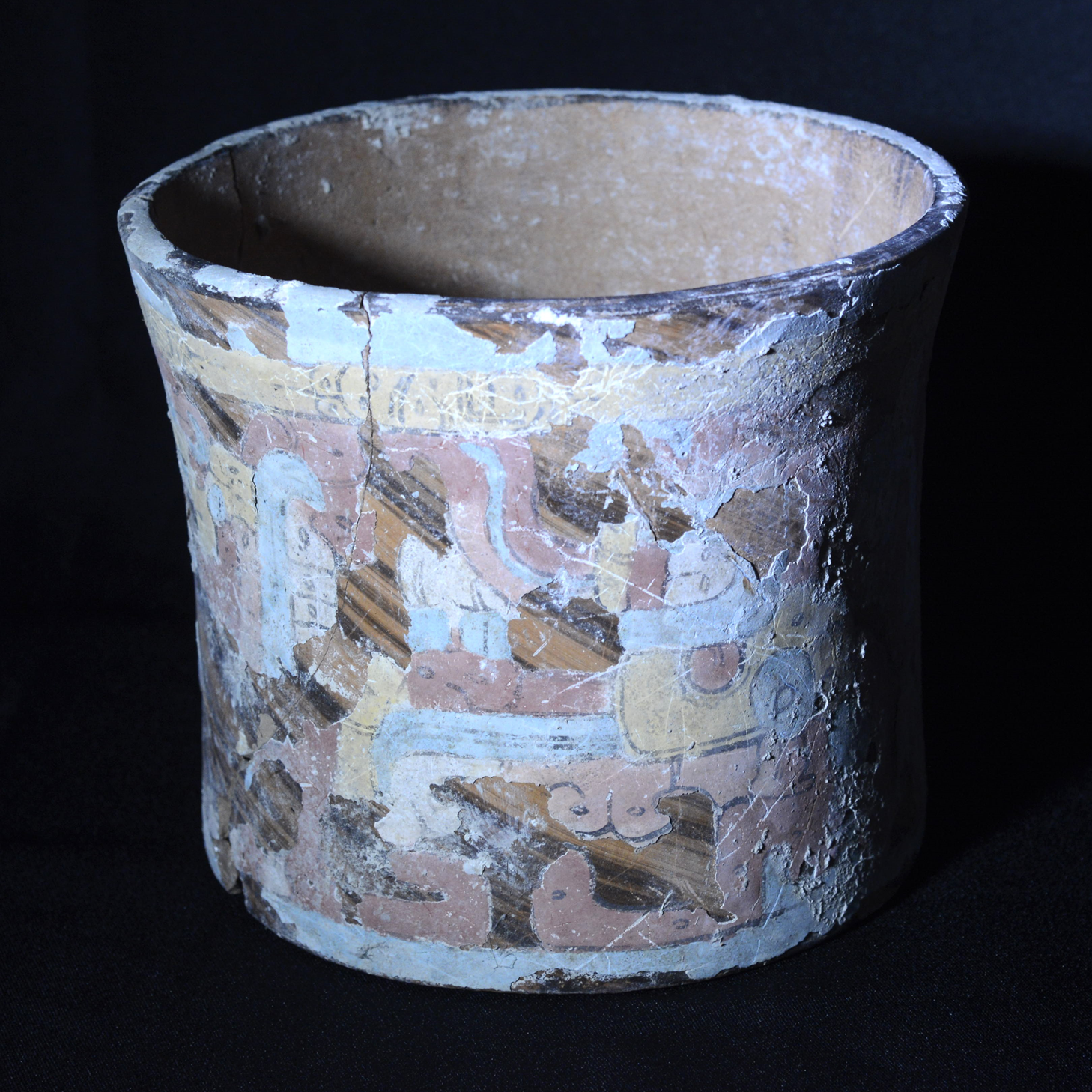
Figure 9. Blue pigment examples, seventh century. Frescoed brownware vase, Burial CHP:BU:B1:7, Cahal Pech (in color online). Image courtesy of Jaime Awe, Belize Valley Archaeological Reconnaissance Project.
The pastel blue-green color (roughly Munsell 10G7/8 to 5BG7/8) of the Cahal Pech vase is typical of other examples of late Early through Middle Classic Maya “blue” ceramic painting from across the lowlands and highlands. Typical also is the fresco mode of application. The Cahal Pech tomb's furnishings also included a transversely halved Caribbean conch shell (probably Turbinella angulate) “paint pot” holding residues of red, black, yellow or white, and deep light-blue pigments (Figure 10; Novotny et al. Reference Novotny, Awe, Santasilia and Knudson2018:648; Santasilia Reference Santasilia2013:38, 40, 51–52, figure 42b). This cut-shell palette is one of the most substantial pieces of evidence for local painting with Maya Blue yet discovered in the Belize Valley.
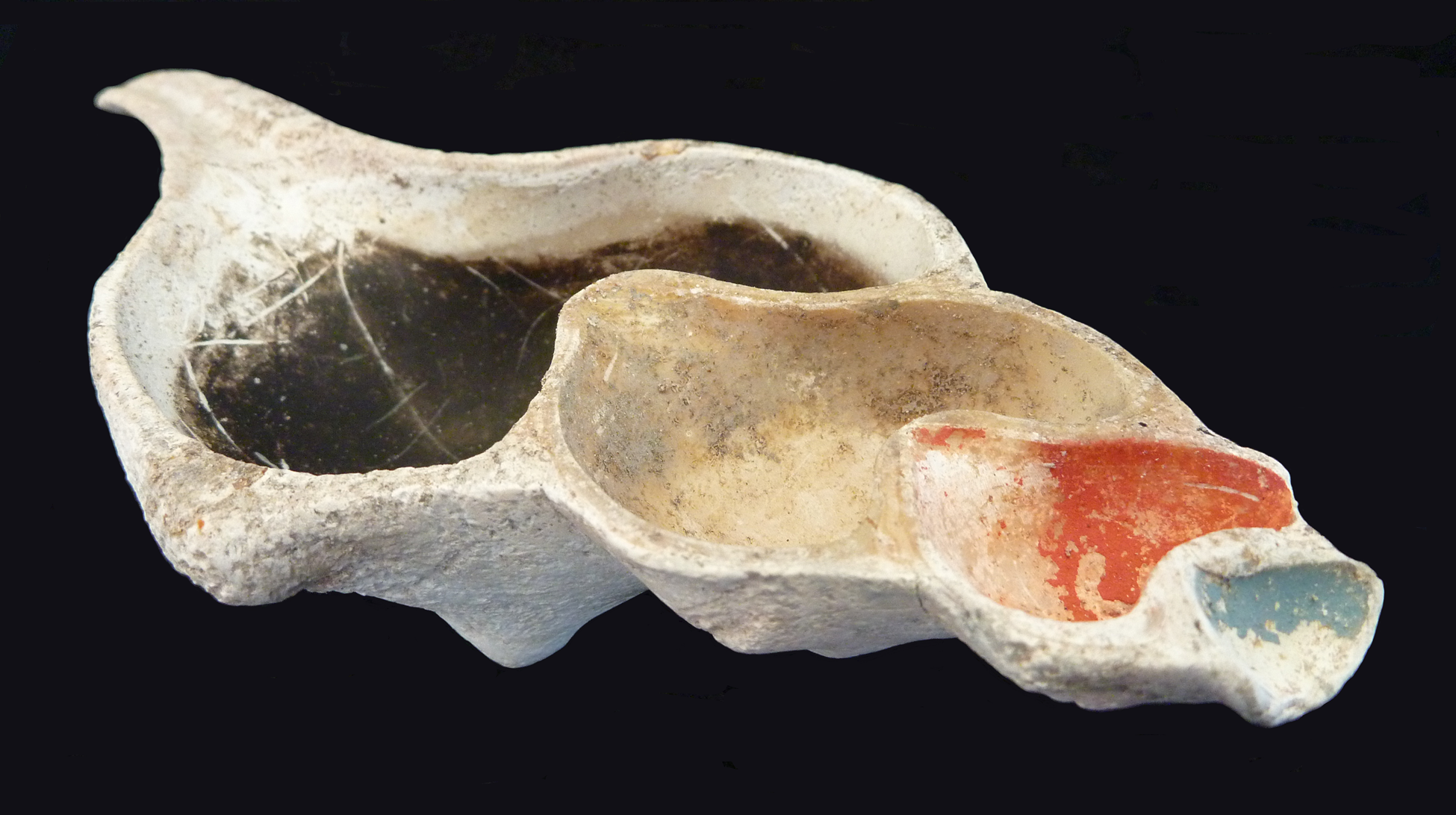
Figure 10. Blue pigment examples, seventh century. Halved conch “paint pot” with Maya Blue, red, yellow or white, and black pigment residues. Burial CHP:BU:B1:7, Cahal Pech. Image courtesy of Jaime Awe, Belize Valley Archaeological Reconnaissance Project.
Similarly frescoed vessels have been found at Rio Azul (Figure 11), Copan, and Kaminaljuyu, some of these of actual Teotihuacan manufacture (Fields and Reents-Budet Reference Fields and Reents-Budet2005:figures 125–126, 128–129, esp. 144; Houston et al. Reference Houston, Brittenham, Mesick, Tokovinine and Warinner2009:figure 4.6). The experimentation with bluish-green to light-blue hues extended from the late fifth century on well into the eighth century in many parts of the Maya lowlands.
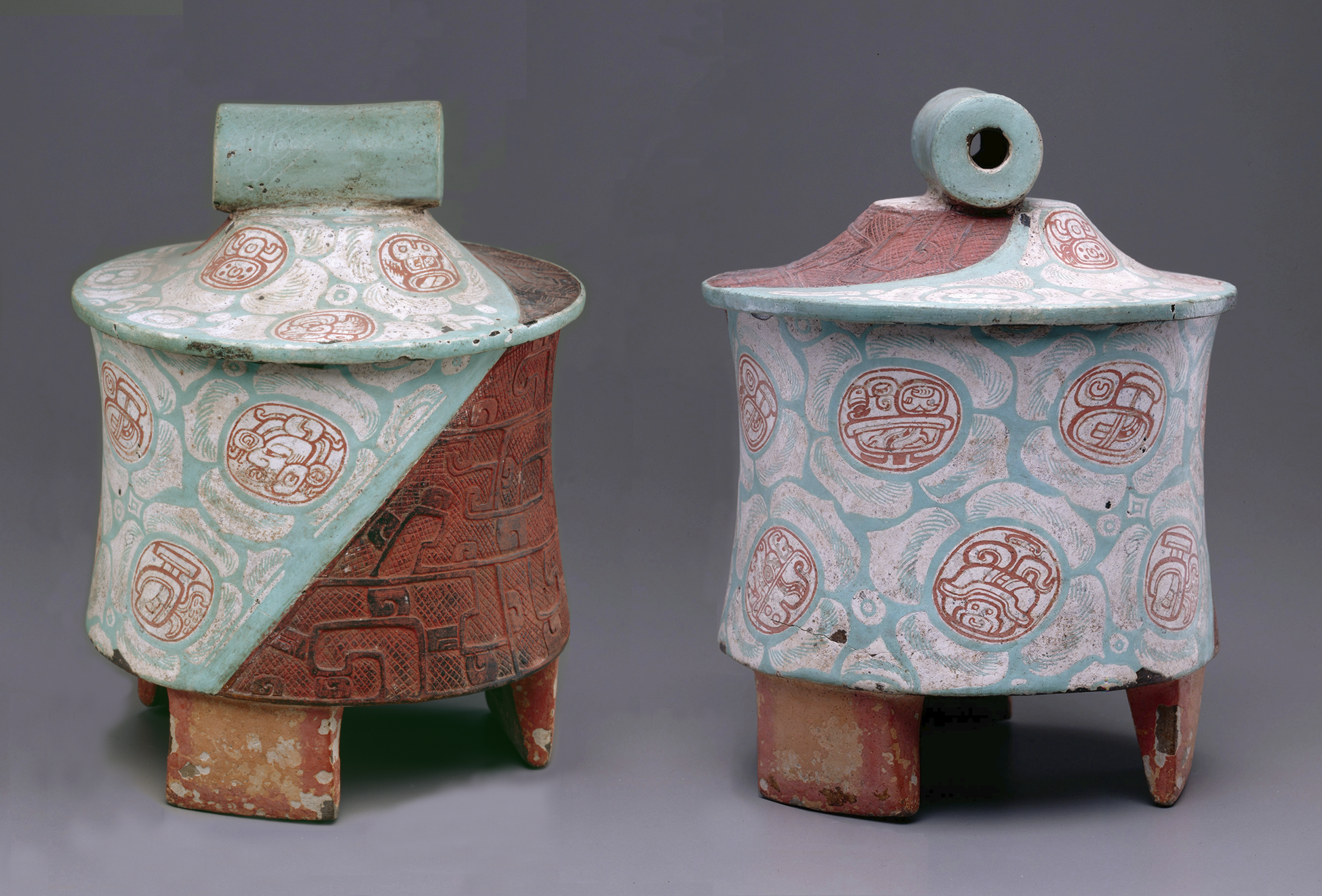
Figure 11. Blue frescoed tripod cylinder vase and apron lid, probably Rio Azul, Guatemala, late fifth century. Two views of same vessel. Public domain, courtesy of The Detroit Institute of Arts, Founders Society Purchase, Arthur H. Nixon Fund, 1984.12.
Sometime after a.d. 760, vases and bowls of the Cordero variety of Cabrito polychrome became progressively more common. While their decoration was also limited to labial and basal bands of color, it was applied directly to the vessels as a post-firing overpaint and presents today as a light matte to intense dull polished blue (Figure 12). Samples from six of these vessels (MAB004, MAB009, MAB011, MAB012, MAB014, MAB016; Table 1) recovered from Buenavista palace feasting, residential, and termination offering deposits were analyzed and presented positive for palygorskite from Sacalum, so by at least this time, the clay mineral or Maya Blue itself was making its way into the upper reaches of the Belize River and had become part of the color lexicon of some Belize Valley and Naranjo-Sa'aal artisans. At Buenavista, Maya Blue was applied to several other wares at this time, notably of the K'om ceramic group (Figure 13), and also was used to accent appliquéd features on some unslipped incensarios and incensario stands (Figure 14). Hermes (Reference Hermes2019:figure 185a) illustrates blue-daubed Pedregal Modeled incensario fragments from Nakum, eastern Petén, identical to ones found at Buenavista.
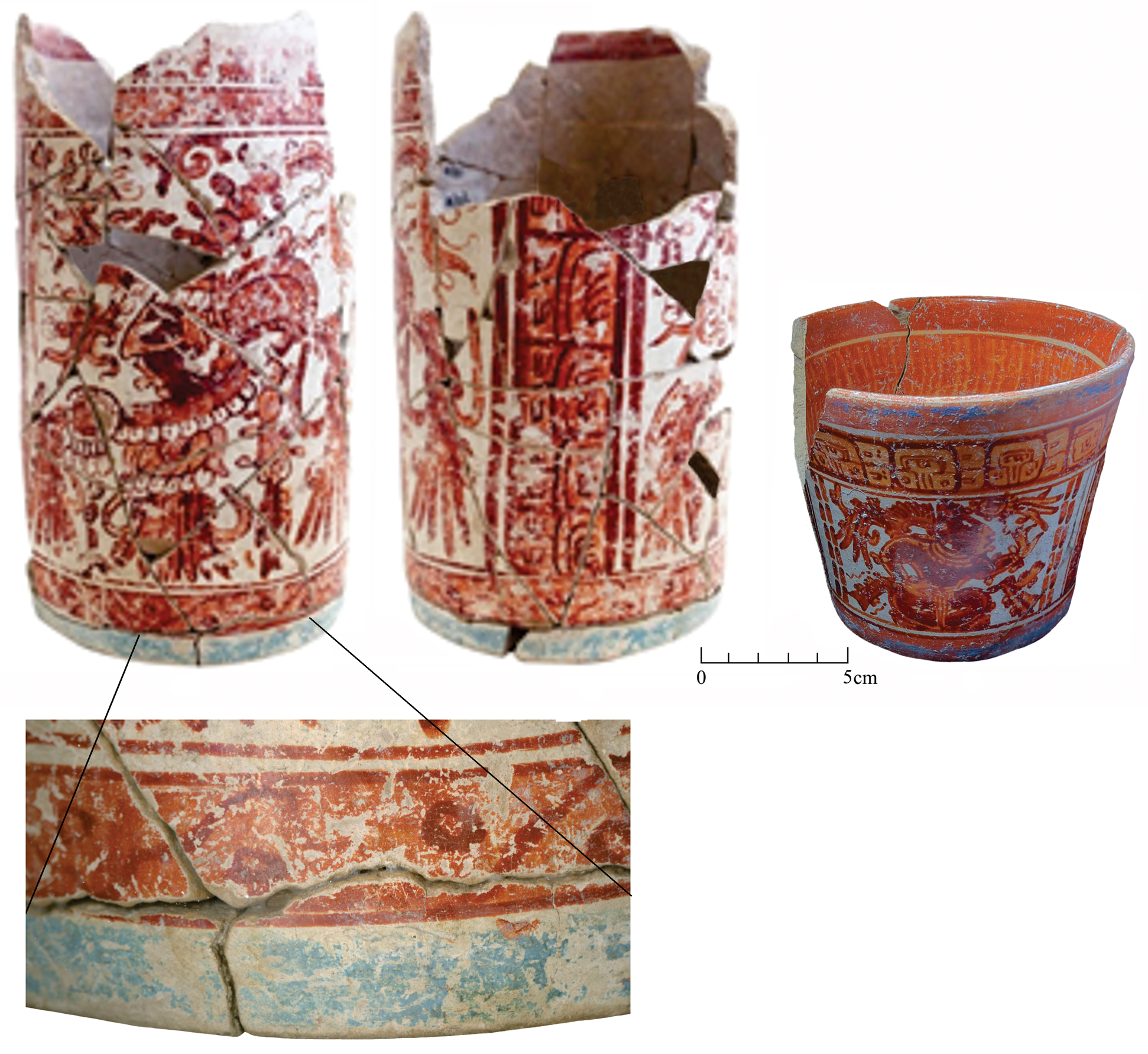
Figure 12. Cabrito Cream-polychrome: Cordero variety. (a) Hun Hunahpú vase, Buenavista, depositional context 32-3, “fancy” early Cordero; (b) Seated Lord program bowl, Baking Pot, “standard” late Cordero. Photos by Jennifer Taschek (a); J. Britt Davis (b).
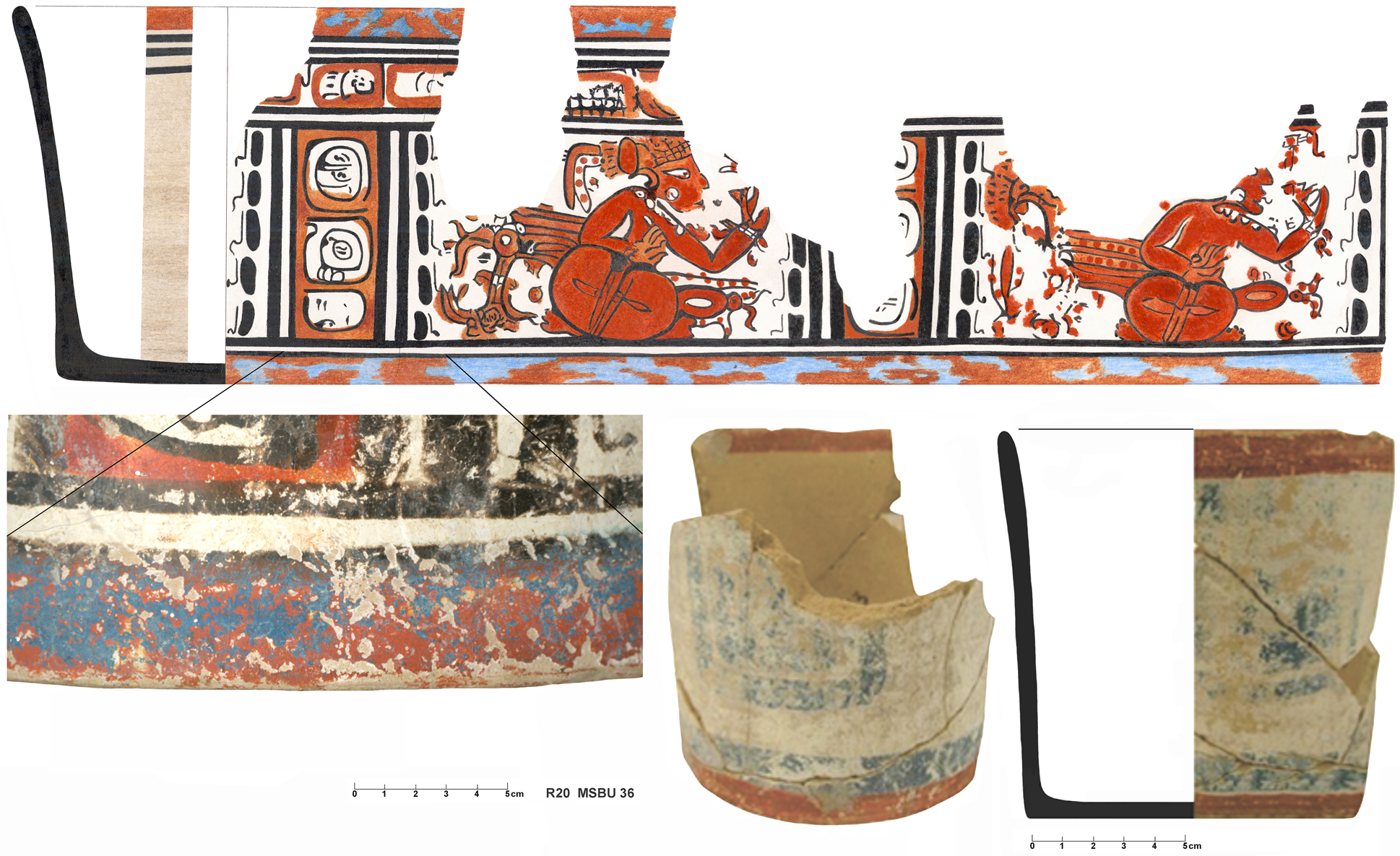
Figure 13. K'om polychrome group bowls. (a) K'om cream-polychrome, Seated Lord program; (b) undesignated blue and red on cream. Both Buenavista palace deposit BVDC 32-3. Drawing and photo by Jennifer Taschek.
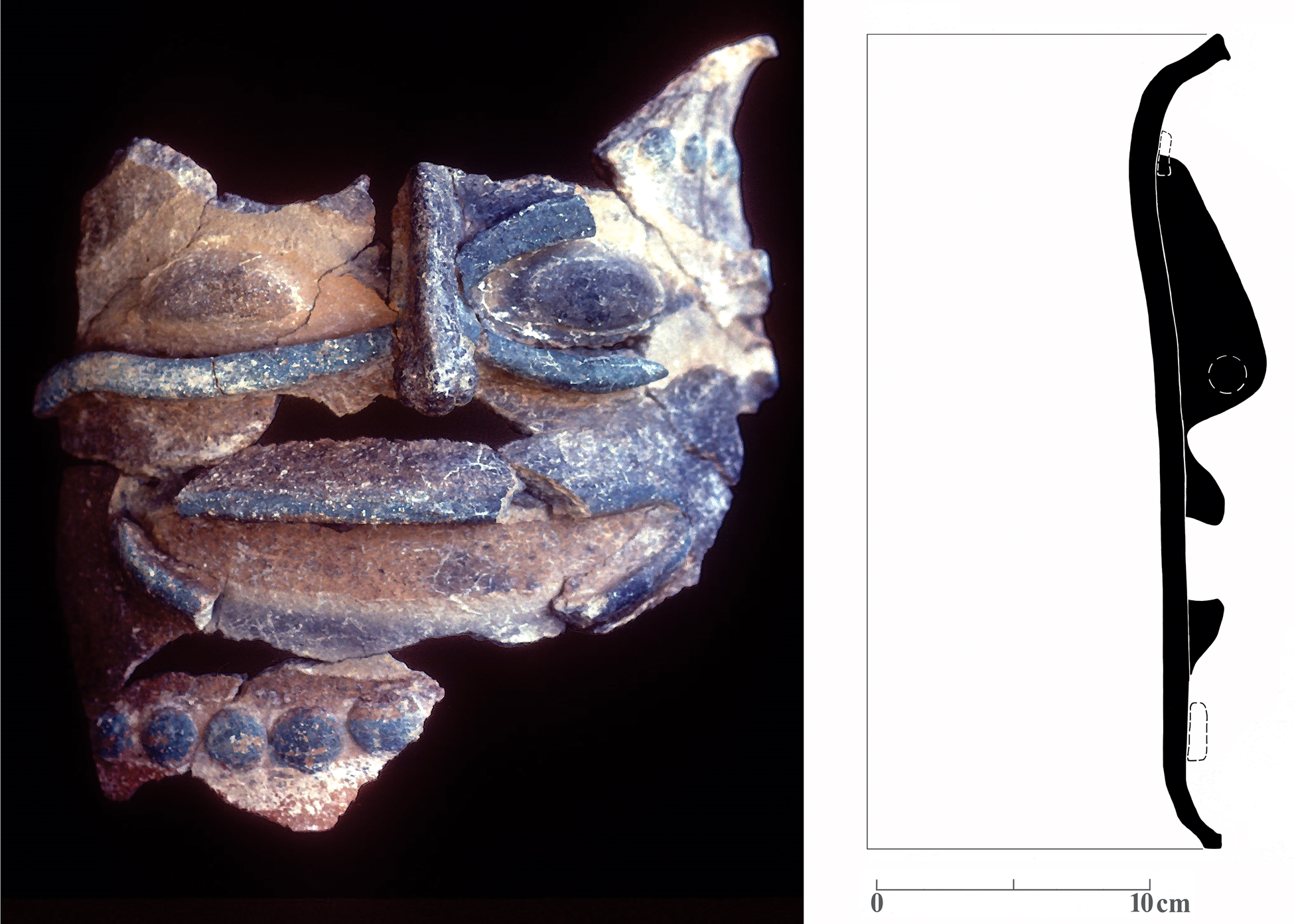
Figure 14. Pedregal modeled. Jaguar God of the Underworld effigy censer stand, mid to late eighth century, Buenavista. Maya Blue daubing to accent appliqué features (in color online). Photo by Joseph Ball.
The royal palace schools of the north and central eastern Petén and the Belize Valley made only occasional, spare use of Maya Blue on the Cabrito and Cordero varieties of Cabrito Cream-polychrome as enhancements to labial and basal bands, typically as a very light- to pale-blue preparation (Figures 7 and 12a). Unlike the very few Cabrito variety examples which employed the same technology as Sample MAB017, samples from Cordero variety vases were found to have been overpainted directly with Maya Blue made with palygorskite that likely originated from Sacalum (Table 1). However, the origination of Cordero variety vessels is a matter of disagreement. Their INAA signatures place their manufacture somewhere in the greater upper Belize Valley region and its environs (Ball et al. Reference Ball, Taschek, Almada and Sears2025), but exactly where is uncertain. Reents-Budet and Bishop (personal communications, 2023) ascribe them to Buenavista. Ball and Taschek, however, believe them to have been produced somewhere in the outlying hinterlands of the Naranjo or El Pilar domains. It should be pointed out that these interlacing territories very probably overlapped each other in the hinterlands west and north of the Belize River during the Late Classic period.
Sometime between a.d. 780 and 810, Maya Blue pigment came into regular use at the Buenavista palace where a resident artist or artisanal group applied it lavishly to embellish basal and labial bands on vessels of the Guajiro variety of Cabrito Cream-polychrome intended for local palace service, occasionally also adding it to other locations on these vessels (Figure 15). Samples from five Guajiro variety vases (MAB002, MAB005, MAB006, MAB008, MAB013; Table 1) presented positive for Sacalum palygorskite in the Field Museum LA-ICP-MS analysis. Maya Blue continued to be used on this ceramic variety until at least a.d. 840~860 (Ball et al. Reference Ball, Taschek, Almada and Sears2025) and continued to be made with palygorskite from Sacalum (MAB003).
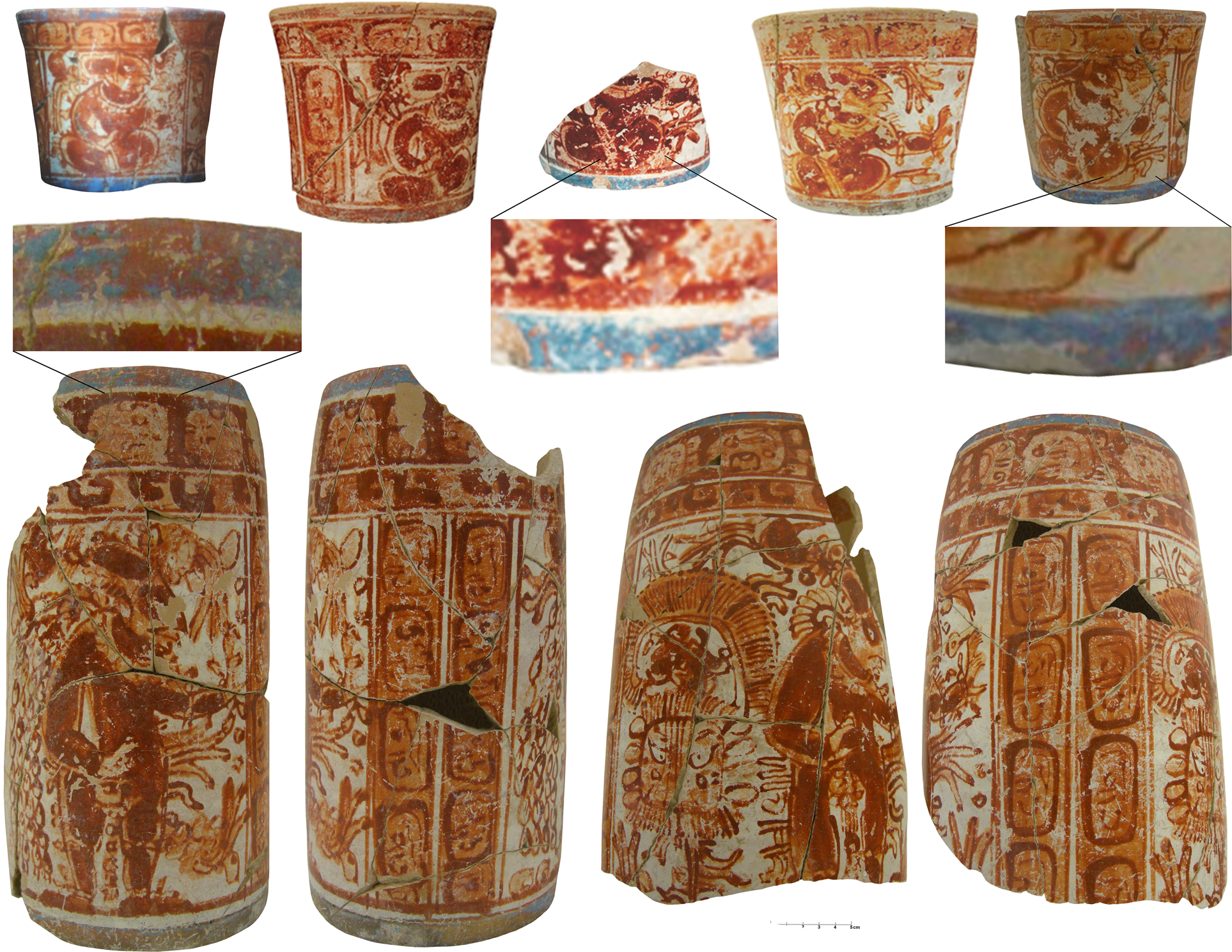
Figure 15. Cabrito cream-polychrome: Guajiro variety. Bowls and vases with Maya Blue labial and basal bands. Enlargements show blue paint applied directly on red-slipped bands. All depositional context BVDC 31-1, Buenavista (in color online). Photos by Joseph Ball.
In addition to pottery vessels, throughout the Late and Terminal Classic periods, Maya Blue also was applied profusely to ceramic figurines, musical instruments (Figure 16), and whistles widely across the eastern, southern, western, and west coastal lowlands, perhaps as an indication of their otherworldly essence. It was especially heavily applied to figurines of the Jaina–Jonuta tradition (Figure 17), almost to the point of being a diagnostic feature. However, despite several intensive studies of Late Classic Maya figurines (Corson Reference Corson1976; Halperin Reference Halperin2014, Reference Halperin2019; O'Neil Reference O'Neil, Pillsbury, Doutriaux, Ishihara-Brito and Tokovinine2012; Taube and Taube Reference Taube and Taube2009), the evidence for this broad use and distribution of Maya Blue remains almost anecdotal, based all but entirely on color depictions in art and art history volumes and archaeology theses. Almost no authors have given attention to the use of blue paint (cf. O'Neil Reference O'Neil, Pillsbury, Doutriaux, Ishihara-Brito and Tokovinine2012:401). Similarly, the extent to which the use of blue pigment on modeled ceramics or figurines might extend back into the Early Classic remains largely unexamined in the literature. An elegant hand-modeled figurine from a late fifth-century tomb at Rio Azul, illustrated by Mary Miller (Reference Miller1999:figure 133), shows remnants of very light-blue paint on its crossed legs.

Figure 16. Maya Blue painted artifacts. Cacao-pod-crocodile rattle-whistle, hand-modeled, ca. a.d. 700–800. Public domain, courtesy of The Metropolitan Museum of Art, The Michael C. Rockefeller Memorial Collection, Bequest of Nelson A. Rockefeller, 1979.
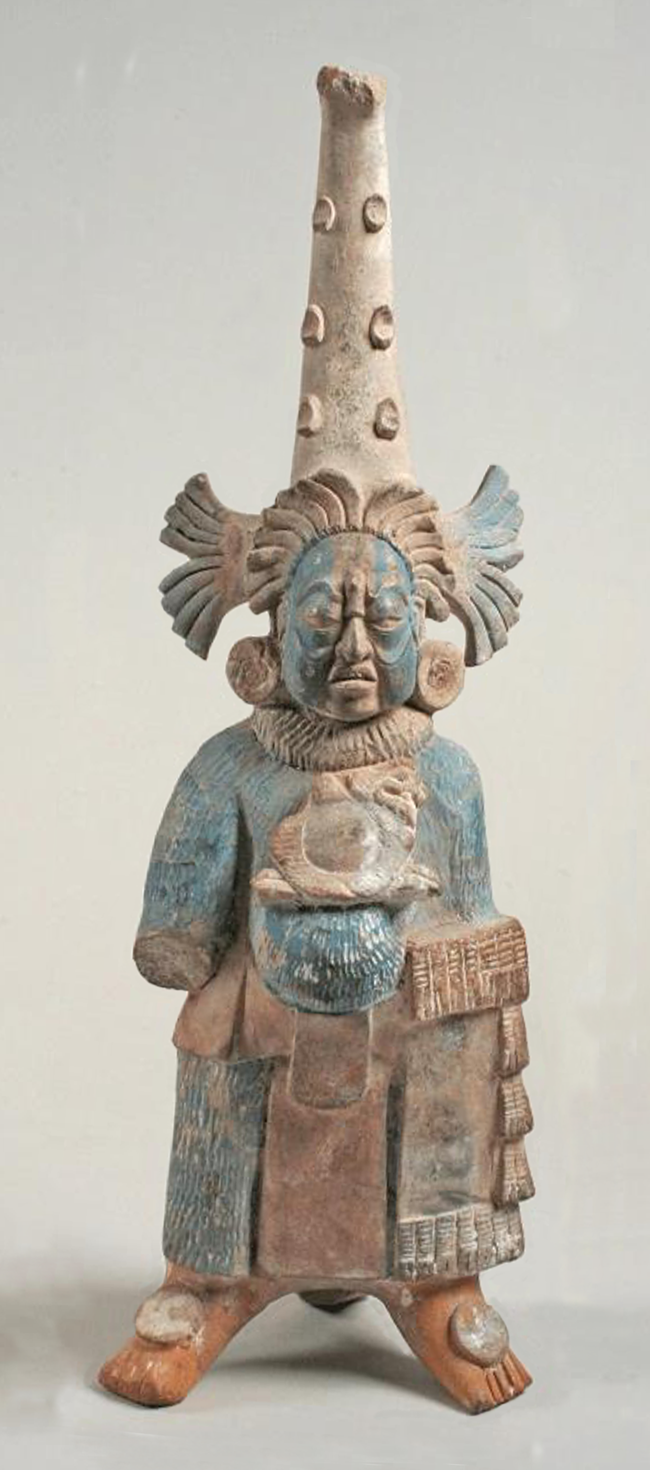
Figure 17. Maya Blue painted artifacts. Jaina figurine, mold-made and modeled depiction of the mythic “Fat Man” as warrior, ca. a.d. 650–900 (in color online). Public domain, courtesy of The Metropolitan Museum of Art, The Michael C. Rockefeller Memorial Collection, Bequest of Nelson A. Rockefeller, 1979.
Compositional analysis of the profuse Jaina–Jonuta tradition Maya Blue pigment has yet to be conducted. However, whatever its origins, it doubtless reached western Campeche and Tabasco by routes other than those serving the Belize Valley and eastern Petén. We have not attempted to delineate any such western courses in the present study.
Complementing earlier findings at Calakmul (Doménech-Carbó et al. Reference Doménech-Carbó, Doménech-Carbó, Vidal-Lorenzo, de Agredos-Pascual, Osete-Cortina and Valle-Algarra2014; Houston et al. Reference Houston, Brittenham, Mesick, Tokovinine and Warinner2009:72–82; Vázquez de Ágredos Pascual et al. Reference Vázquez de Ágredos Pascual, Doménech Carbó and Carbó2011), the Buenavista data suggest that blue painting initially occurred in the eastern Maya lowlands as architectural decoration, appearing at Buenavista by at least the late Early Classic. It later was transferred sparingly to elite ceramics, at first maintaining the architectonic technology. This was done by frescoing vessels rather than applying the blue pigment directly to their surfaces, possibly indicating that it might have been available only in very small batches. Whether the blue pigment arrived as ready-to-use paint or was prepared on site from imported palygorskite and from processing Indigofera suffruticosa locally, its abstemious use would seem to suggest that local artists had access to it only in limited quantities.
By the 760s, Sacalum palygorskite-based Maya Blue was in occasional and limited use by artists painting fine polychrome ceramics for the elites of the upper Belize Valley and Greater Naranjo domains. It continued to occur predominantly as post-firing embellishments to labial and basal bands on both vases and bowls, particularly of the Cabrito Cream-polychrome group. The evidence from Buenavista, Cahal Pech, and nearby Baking Pot suggests that the application of Maya Blue increased in frequency in the Terminal Classic, and also expanded to pottery wares other than those of the Cabrito series, including both cream-based and orange-based polychromes (Figure 18). Peaking in frequency in the first half of the ninth century, its use in ceramic decoration abruptly halts after a.d. 860, at least in the greater eastern lowlands. Farther inland to the west and southwest, pottery painting with Maya Blue continued on well into or reappeared again during the regional Postclassic. By then the production of Maya Blue may have become reliant on new sources of palygorskite as Cecil's (Reference Cecil2010) discovery of a different source of the mineral might indicate. Further, the use of a different source than Yucatan for the palygorskite in some samples of Aztec Maya Blue (Sánchez de Río et al. Reference del Río, Manuel, Suárez and García-Romero2021), and the Aztec use of sepiolite and sepiolite/palygorskite mixtures in the pigment further points toward a re-orientation of the sources of clays to make the pigment (summarized in Arnold Reference Arnold2024:190–194).
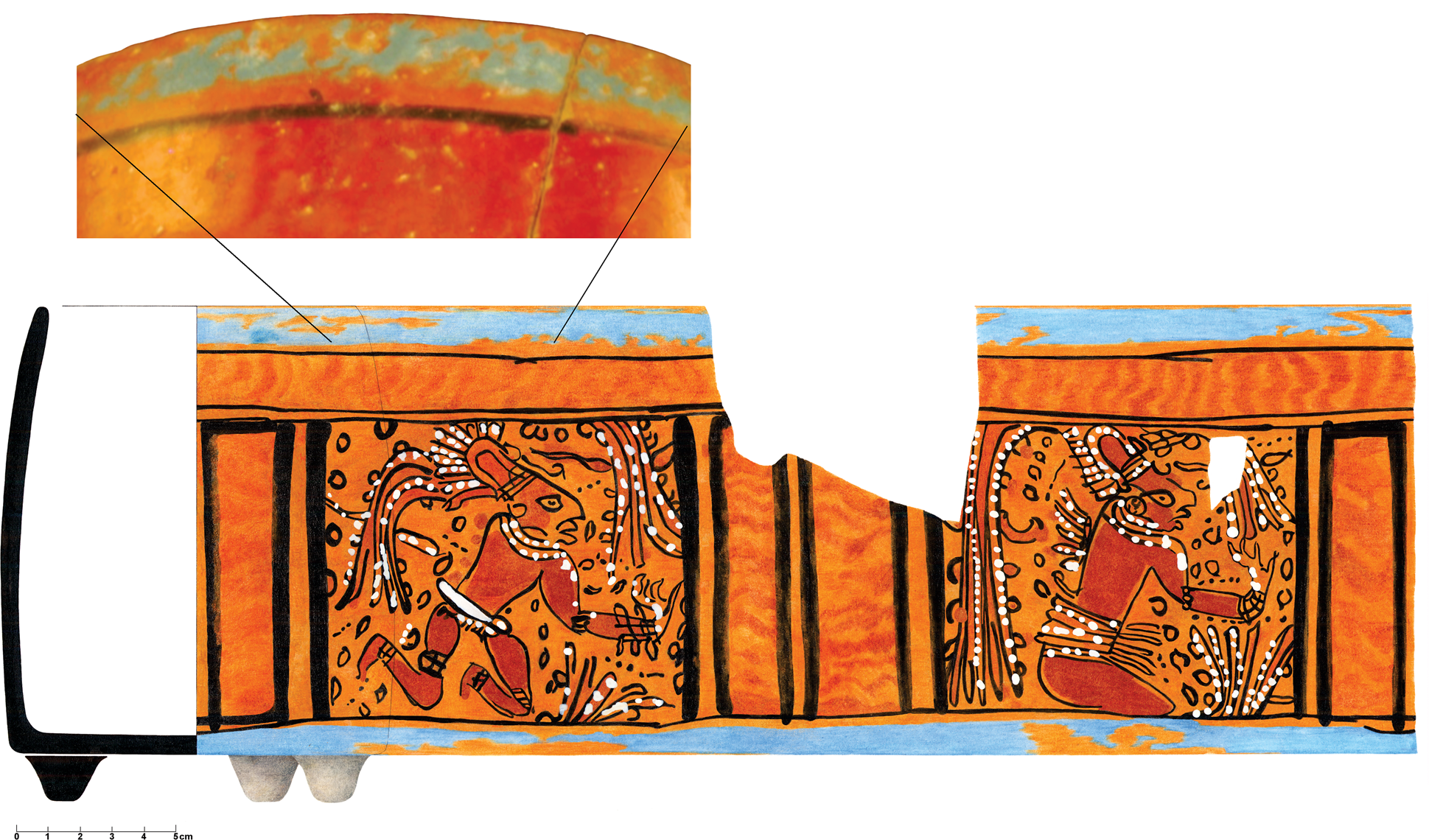
Figure 18. Velloso orange-polychrome: variety unspecified. Late ninth-century tripod vase, depositional context BVDC 31-2, Buenavista (in color online). Drawing and photo by Jennifer Taschek.
Routes of conveyance in the Late and Terminal Classic periods, ca. a.d. 750–900
Instrumental neutron activation analyses of several ceramic vessels sampled for this study indicate that the Cordero and Guajiro varieties of Cabrito polychrome were most likely manufactured somewhere within about 5 km or so of Buenavista (Ball et al. Reference Ball, Taschek, Almada and Sears2025). Extensive archaeological evidence exists that vessels of the Guajiro variety were painted and fired on the front terrace of one of Buenavista's palace buildings, Structure 31 (Figure 3; Ball et al. Reference Ball, Taschek, Almada and Sears2025). All Guajiro variety and several Cordero variety vessels were lavishly embellished with Maya Blue labial and basal banding (see Figures 12b and 15). LA-ICP-MS trace-element analyses of the Maya Blue embellishing the Guajiro and Cordero variety vessels indicate that the palygorskite used to make it came from Sacalum, 375 linear kilometers north-northwest on the Yucatan coastal plain. Either Maya Blue pigment or the palygorskite used to make it together with the knowledge of how to produce it were conveyed from central Yucatan to the upper Belize River Valley, or to nearby Naranjo-Sa'aal to which Buenavista was subordinate during much of the Late and Terminal Classic periods.
A very small number of Cabrito variety exotics came from as far as 14 to 24 km away to the west (circum Naranjo) and north (circum Holmul). Macroscopic examination and LA-ICP-MS analyses of three non-Cabrito-type vessels from Buenavista decorated in the same manner as the Cabrito variety examples indicated that the embellishing pale-blue preparation differed significantly in trace-element composition.
It is conceivable that the Maya Blue preparation or palygorskite and the specialized knowledge for its production traveled southward overland via the centers and towns of southern Yucatan, Campeche, and Quintana Roo to reach the eastern Petén and thence the Belize Valley (Hauck Reference Hauck1975; Nelson Reference Nelson1973, Reference Nelson1985, Reference Nelson, Gaxiola and Clark1989; Roys Reference Roys1943). Maya Blue has been recorded on both ceremonial vessels (Paaktzatz Modeled; Pastelaria composite; Cumtun composite [Ball Reference Ball1977:110, 120, 122–124]) and northern thin-slate tripod dishes (Xul Incised [Ball Reference Ball1977:90]) from Becán, southeastern Campeche, from several Late and Terminal Classic contexts. Forsyth (Reference Forsyth1983:109; 171–172) reports identical post-firing blue applications to Xul Incised tripod dishes from Edzná. Blue painting is, however, otherwise rare to absent on Late Classic pottery from the central lowlands and north and central Petén sites such as Uaxactun (Smith Reference Smith1955) and Tikal (Kosakowsky, personal communication 2024). In his monumental study of the ceramics of Tikal, Culbert (Reference Culbert1993; Culbert and Kosakowsky Reference Culbert and Kosakowsky2018) never once employs the term “blue,” but describes rare “blue green” and “greenish” hues on stuccoed vessels. In total, he reports only three such vessels for the entire seventh and eighth centuries, one from a seventh-century offering cache (“green on stucco,” Culbert Reference Culbert1993:figure 114g) and two from early eighth-century tombs (BU 116- Culbert Reference Culbert1993:figure 68a, “pale blue green on stuccoed rim”; BU 196- Culbert Reference Culbert1993:figure 91a, “greenish cast on stucco”).
Generally, the absence of evidence cannot be construed to be evidence of absence. However, in this case, the anecdotal dearth of reported instances of blue-painted ceramics other than figurines and musical instruments in the archaeological records of the central lowlands and Petén does tend to suggest a circumpeninsular maritime transit between northwest Yucatan and the upper Belize Valley occurrences. The Becán and a scant few other spotty occurrences apart (e.g., Tulix Mul, northwestern Belize [Hammond Reference Hammond2019:figure 8.92]), it is more probable that maritime Maya canoers carried palygorskite and the technology for its transmutation along the coast from north central Yucatan or northeastern Quintana Roo to the mouth of the Belize River and then up the latter to Buenavista which sits but a few hundred meters back from its east bank.
Two plausible routes exist (Figure 1). One, the most probable ninth-century route, passed via the great Terminal Classic commercial center, Chichén Itzá, some 107 km east-northeast of Sacalum, and continued on 102 km north-northeast to its coastal port facility, Isla Cerritos (Andrews Reference Andrews, Hutson and Ardren2020:275–276, figure 15.1; Andrews et al. Reference Andrews, Negrón, Castellanos, Palma and Rivero1988; Reference Andrews, Negrón and Cobos P.1989; Ardren and Lowry Reference Ardren and Lowry2011; Gallareta Negrón et al. Reference Gallareta Negrón, Andrews, Palma and Rivero1989). From there, seagoing canoes carried goods eastward around Cabo Catoche and down the Quintana Roo coast to the significant maritime entrepôt of Marco Gonzalez at the southern tip of Ambergris Caye (Andrews Reference Andrews, Hutson and Ardren2020:figure 15.1; Graham and Simmons Reference Graham and Simmons2011; Simmons and Graham Reference Simmons, Graham, Patton and Manion2016). Small villages, towns, and ports dotted the coastline from Cerritos to Marco Gonzalez, a nautical distance of roughly 600 to 620 km, depending on shoreline stopovers. One of these was Vista Alegre at the northeast corner of the Yucatan littoral 110 km east of Cerritos, a small coastal port facility with well-documented ceramic ties to Belize (Ball et al. Reference Ball, Glover, Rissolo, Berdugo, Glover and Rissolo2010; Glover et al. Reference Glover, Hruby, Rissolo, Ball, Glascock and Steven Shackley2018).
A more likely Late Classic route would have taken Sacalum palygorskite east some 96 km to the major Late Classic center, Yaxuná. From there, a raised, 10 m wide, plaster-paved sacbe runs eastward 100 km to the giant Late Classic metropolis, Cobá, only 43 km from the Quintana Roo coast at Xelhá (Andrews Reference Andrews, Hutson and Ardren2020:275, figure 15.1). From Xelhá, Marco Gonzalez lies about 295 km south along the coast.
By whichever route, possibly competitors in the early ninth century, merchants and their goods would ultimately have put up at Marco Gonzalez at the southern tip of Ambergris Caye opposite the north central Belize coast. Excavations at Marco Gonzalez have documented the presence of true Late and Terminal Classic northern fine wares such as Tabi Gouged-Incised Puuc slateware (Figure 19a) and Teabo Red—Puuc redware—as well as extensive other ceramic and artifactual evidence of “international” trade including Fine Orange Paste-Ware from Tabasco and Tohil Plumbate from coastal Soconusco (Graham and Simmons Reference Graham and Simmons2011; Neff Reference Neff, Robinson and Davies2023; Neff et al. Reference Neff, Castillo, Sakai, Stanton, Taube, Coltman and Marengo Camacho2023; Reed Reference Reed2023). From Marco Gonzalez, it is 20 km across shallow coastal waters to a series of coastal sites along Northern River Lagoon where fancy pottery originating in the upper Belize Valley (Puhui-zibal composite vases) and elsewhere inland has been found (Figure 19b; Ball et al. Reference Ball, Taschek, Almada and Sears2025; Mock Reference Mock1997, Reference Mock2000). Forty-three kilometers farther south of Marco Gonzalez along the coast lies the mouth of the Belize River. The river is navigable to just above the Buenavista site, a little over 112 km from its mouth, and as late as the middle twentieth century, paddlewheel riverboats engaged in the chicle and mahogany trade came upriver to present-day San Ignacio Town (formerly El Cayo), just 9 km below Buenavista, “gateway” to the Petén for late nineteenth- and early twentieth-century chicleros and archaeologists (Buhler Reference Buhler2004; Schwartz Reference Schwartz1990).

Figure 19. Foreign wares at Marco Gonzalez and Northern River Lagoon, Belize. (a) Puuc slateware, Tabi Gouged-Incised, from Marco Gonzalez; (b) Puhui-zibal composite: Puhui-zibal variety vase from Northern River Lagoon, central Belize coast (in color online). Photos by (a) Joseph Ball and (b) Collin Sauter, courtesy of Elizabeth Graham.
The historic and modern era role of the ford near Buenavista is important to appreciating its role in the transmission into the eastern Petén of palygorskite from faraway Yucatan. Otherwise, it is difficult to explain why this modest center in the upper Belize River Valley would have enjoyed access to the quantities of Maya Blue pigment that it clearly did. The Buenavista artist or artists benefited from their place as pivotal in the transmission of palygorskite and the esoteric knowledge for its conversion into the hallowed pigment so highly prized by the failing courts of the ninth-century Petén.
Retrospect and conclusion
Maya Blue was never just an embellishment of pottery vessels, figurines, and the other objects and implements to which it was applied. It was, first and foremost, a vivid visual signaling of the sacrosanct nature of those objects and the elevated status of those who possessed and displayed them, possibly even ritually ensouling and activating them with ch'ulel, the sacred life force believed by the Maya to be present in all living and inanimate things (Freidel et al. Reference Freidel, Schele and Parker1993; Taube Reference Taube2005), binding together the universe and connecting humankind to ancestors and deities (Demarest Reference Demarest2004).
Like elaborately worked jadeites, spondylus valves, and iron-ore mosaic mirrors, Maya Blue paint was itself a tangible prestige good, likely essential to the proper functioning of thriving Late and struggling Terminal Classic royal courts (McAnany Reference McAnany, Hirth and Pillsbury2013). Maya elites did not necessarily need to know how to produce the pigment themselves but were eager to possess objects embellished with it. Access to the pigment or palygorskite and the knowledge of how to transmute it into the sacral color would have enormously empowered any artisans possessing these.
The ideological significance and role of the color blue to the Postclassic Maya are well known (Tozzer Reference Tozzer1941, Reference Tozzer1957; Vail Reference Vail2006; Vail and Hernández Reference Vail and Hernández2018). It symbolized water, rain, and fertility and was used for sacrifices to the rain god Chaahk. It also symbolized Chaahk himself as well as other deities, including Itzamná. Possibly the sacral blue color and its preparation were also associated with the ca. a.d. 750~950 Epiclassic “cult of Quetzalcoatl,” which was spreading across eastern Mesoamerica and the Maya lowlands during that era (Ringle et al. Reference Ringle, Negrón and Bey1998).
But there is scant evidence for the presence of the Quetzalcoatl cult at Buenavista or elsewhere in the Belize Valley. Perhaps Chaahk, symbolized by Maya Blue and already long established at Buenavista (Yaeger Reference Yaeger2024; Yaeger et al. Reference Yaeger, Cap and Kathryn Brown2023), supplanted cult figures of Quetzalcoatl in response to the increasing frequencies and severities of droughts (Gill Reference Gill2001; Moyes et al. Reference Moyes, Awe, Brook and Webster2009; Seligson Reference Seligson2023).
From sometime after a.d. 760, Maya Blue became an increasingly important component of high-status polychrome pottery-finishing in the upper Belize River Valley and circumjacent eastern Maya lowlands. It only grew in importance in the troubled years of the ninth-century Terminal Classic and remained in use in the region until at least a.d. 850/60.
At Buenavista, a seeming focal nexus for the pigment in the late eighth and early ninth centuries, the Guajiro variety Cabrito polychrome ceramics to which Maya Blue was lavishly applied provided a visual charter underwriting the sovereignty, authority, and divine right to rule of the remnant local elites residing within the center's fortress-like west palace (Ball et al. Reference Ball, Taschek, Almada and Sears2025). The blue coloring was a palpable emblem of the high, holy status of those who possessed and displayed those vessels. Their transfer between centers and individuals involved limited and likely sanctioned high-status sociopolitical or ceremonial engagements and gifting exchanges rather than commercial trade.
Jason Yaeger (Reference Yaeger2024) has posited a special relationship and even possible identification of the Buenavista royal lineage with the god Chaahk from at least the late Early Classic. The association of Chaahk with the color blue is well established (Arnold Reference Arnold2024) and could have made the hue sacrosanct at Buenavista and emblematic of its rulers. Such symbolic import for the pigment would account for its seeming concentration at the center—atypical and anomalous—and its regular use in embellishing the Late and Terminal Classic painted pottery produced there (Ball et al. Reference Ball, Taschek, Almada and Sears2025). Conceivably, artisans from Buenavista might have sought out the source of the wondrous pigment and the secret of its fabrication, having earlier become familiar with it from whistles, figurines, musical instruments, and architectural decoration. Small-scale sumptuary import by courtly artists would certainly describe the archaeological patterning of its documented distribution.
But what was the origin of the blue pigment so lavishly employed by potters in this region? Did it have a single common source or multiple origins? Moreover, why Buenavista? How did Maya Blue come to be so heavily available to this relatively small, modest riverside center on the upper Belize River in its waning days of the early ninth century?
In an effort to address these questions, we submitted 20 potsherds from Buenavista del Cayo for LA-ICP-MS analysis at the Chicago Field Museum Elemental Analysis Facility (Table 1; Supplemental Table 1). Three of these proved to be too small to be suitable for laser ablation analysis. The 17 samples analyzed represented six distinct varieties (five types) as classified using the type-variety system of analysis. The samples ranged in age from the late seventh to the middle ninth century a.d. Three samples dating from ca. a.d. 680 to 720 were singularly high in calcium content, as might be expected if a small amount of Maya Blue was added directly to wet plaster in true fresco mode. Analyses of the 14 samples dating from after a.d. 760 to 860 indicated that they all but certainly were embellished with Maya Blue made with palygorskite from a source at Sacalum, Yucatan, located about 375 km northwest of Buenavista. How the palygorskite and knowledge for its concoction or the finished blue pigment reached the upper Belize Valley is less certain, but there are reasonable probabilities.
We have proffered three plausible routes by which the pigment or palygorskite and the knowledge necessary for its concoction could have been conveyed. One of these was by way of Chichén Itzá, a major center of the worship of both Quetzalcoatl/Kukulcan and Chaahk. The senior author (Arnold Reference Arnold2024) and Mary E. Miller (Reference Miller, McEwan and Hoopes2021:102) each independently have suggested that this was an important Postclassic and Terminal Classic locus of the ceremonial fabrication of Maya Blue from Sacalum palygorskite. Mayapan, 93 km west of Chichén Itzá and only 20 km northeast of Sacalum, is another plausible candidate for the pigment's fabrication in the full Late Postclassic.
The authors do not mean to suggest that a Maya Blue preparation was manufactured at one of these northern centers or Sacalum as a commercial trade item and shipped in ready-to-use form to Buenavista or anywhere else. Among the artifacts recovered from depositional context DC31-1 at Buenavista—unreported in Ball et al. Reference Ball, Taschek, Almada and Sears2025—was a large circular segment from the base of an unslipped utility jar (Cayo Unslipped). It held an adherent white plaster-like residue swirled with deep light-blue coloring visually and texturally similar to that present on the Mayapan Red Osario bowls from Chichén Itzá in the Field Museum collection (Arnold Reference Arnold2024:156–174). This residue has not undergone formal analyses but is stored with the Buenavista collections in San Ignacio, Belize.
Rather than thinking of Maya Blue or palygorskite as commodities, what became a highly valued sumptuary article for the ancient Maya was palygorskite together with the esoteric knowledge necessary for its transmutation into a stable blue pigment. This was achieved by grinding palygorskite—a mineral known to have medicinal properties for the contemporary Maya—together with the leaves or leachate of the leaves of the indigo plant, which was also of medicinal importance and then heating the mixture in a tripod bowl (Arnold Reference Arnold2024:142, 156–175). Real and ascribed value lay in the hue itself, and in the tightly controlled abilities to produce, apply, and display the sacral color or objects adorned with it. Given the probable privileged nature of the knowledge involved, those abilities are more likely to have been associated with attached or even “embedded” artists and their patrons than with independent artisans (see Arnold Reference Arnold2024:172–174; Inomata Reference Inomata2001, esp. 323).
Multiple lines of archaeological evidence support travel and mercantile passage between Chichén Itzá and other locales in Yucatan and the central Belize littoral—including the mouth of the Belize River—and point farther south along the coastal waterways of the eastern peninsula (Andrews Reference Andrews, Hutson and Ardren2020; Ardren and Lowry Reference Ardren and Lowry2011; Doyle et al. Reference Doyle, Hoopes, Marín, McEwan and Hoopes2021; Edwards Reference Edwards, Lee and Navarette1978; Glover et al. Reference Glover, Hruby, Rissolo, Ball, Glascock and Steven Shackley2018). The Belize River is navigable by canoe upstream to just where Buenavista is situated.
We may never know the specific mode of transmittal by which palygorskite and the recipes for making Maya Blue with it might have reached Buenavista and the eastern Petén. The same purveyors might have carried the palygorskite and this knowledge, as well as more commonplace commodities. However, even traveling via the same routes as such quasi-quotidian goods as obsidian and cotton mantles, they are more likely to have been carried by emissaries offering high-value sacred knowledge and its instruments than by commercial merchants. The anticipated consumers were elites and, more so, the elite artists and artisans who serviced their needs. Their transit was more likely to have involved limited, possibly restricted high-status ceremonial or sociopolitical engagements than commercial trade.
Alternatively, socially sanctioned emissaries from Buenavista might have made the long roundtrip downriver, around the coast to Yucatan, and back again to secure the precious amalgam of materials and knowledge. Ultimately, Sacalum palygorskite-based Maya Blue was applied to fine ceramics and other objects destined for Buenavista and greater eastern Petén royal courts and royalty both to affirm their sacral status and to sanctify those objects and imbue them with sacred ch'ulel.
Acknowledgments
This paper is a result of a long series of multi-funded ethnographic and archaeological field work sessions and examination of museum material over a period of 59 years. For the first author, the funding sources and the many individuals who contributed to this research are gratefully acknowledged elsewhere (Arnold Reference Arnold2024:xvii–xx). Most recently, we are especially grateful for a grant from the National Geographic Society (Grant Number 8433-08) that allowed the senior author and B. F. Bohor to collect a massive number of samples of palygorskite from several locations in 2008. Gary Feinman, Chris Phillip, and Julie Kennedy facilitated access to the specimens in the collection of the Field Museum.
The investigations from which the Buenavista archaeological data derive were supported by grants from the National Science Foundation (BNS-8310677; BNS-8719157), San Diego State University, and multiple private donors. Permission to conduct fieldwork at Buenavista was graciously extended through the Belize Department of Archaeology by successive Commissioners of Archaeology, Mr. Harriot TopseyFootnote † and Ms. Winnel BrancheFootnote †, and by Sr. Pablo GuerraFootnote † and the Guerra family on whose ranch the Buenavista site is located. INAA analyses of the Buenavista ceramic samples formed part of the larger Maya Ceramics Project and were carried out at the National Institute of Standards & Technology National Center for Neutron Research directed by Ronald L. Bishop and supported by the Smithsonian Institution.
Jaime J. Awe, James Aimers, and J. Britt Davis each generously shared photographic images and data with us. Jason Yaeger kindly shared insights into his own ongoing research at Buenavista. We thank each one for their collegial generosity. We also thank our three anonymous manuscript reviewers for their helpful suggestions for improving the article. The authors take sole responsibility for any errors of fact, interpretation, or other shortcomings from which this paper may suffer.
Supplemental Materials
The supplementary material for this article can be found at https://doi.org/10.1017/S0956536125000082
Supplemental Table 1. Blue-embellished pottery sherds from Buenavista del Cayo, Belize submitted for LA-ICP-MS palygorskite analysis by the Elemental Analysis Facility, Field Museum, Chicago. Sample type-variety and form classifications; contexts; images; MMTAP Project Sample Numbers; and Field Museum Sample Numbers.
Supplemental Table 2. Results of LA-ICP-MS analysis of Maya Blue pigment on ceramic sherds from Buenavista del Cayo, Belize.
Competing Interests Declaration
The authors declare there to be no competing interests.
Data Availability Statement
All palygorskite standards examined for this study are curated at the Elemental Analysis Facility, Field Museum, Chicago. The Buenavista pottery sherds are curated by Collections Management, Historical Archaeology and Maya Research Lab, San Diego State University. Additional information on these samples and the original Excel spreadsheets presenting their elemental analyses are provided in Supplemental Tables 1 and 2 and are available from the paper's respective institutional co-authors upon request.

